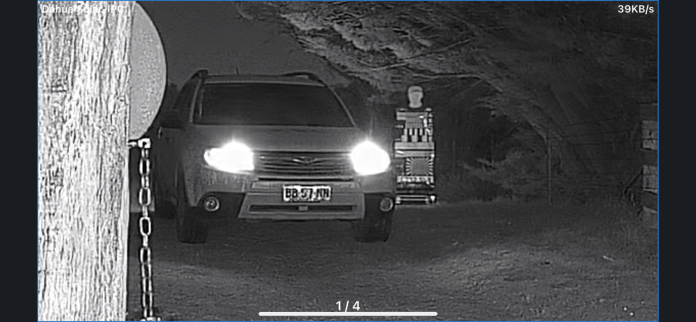Dahua 4G Solar Camera Review
♦ Dahua 4G Solar Camera Review – Dahua’s 4G solar camera has an impressive specification and good camera performance but it’s the flexibility of this form factor that really counts.
Dahua’s 4G solar solution incorporates a 2MP or 4MP fixed lens WizSense camera with IR, a solar panel, MPPT controller and lithium battery combined in an integrated mount.
There’s RJ45 as well as RS485 comms to go with the 4G, the maximum power point tracking (MPPT) charging controller converts over voltage to charging amps, making the solar array 30 per cent more efficient, and the charging system features current limiting, overvoltage, over-discharge, and reverse connection protection.
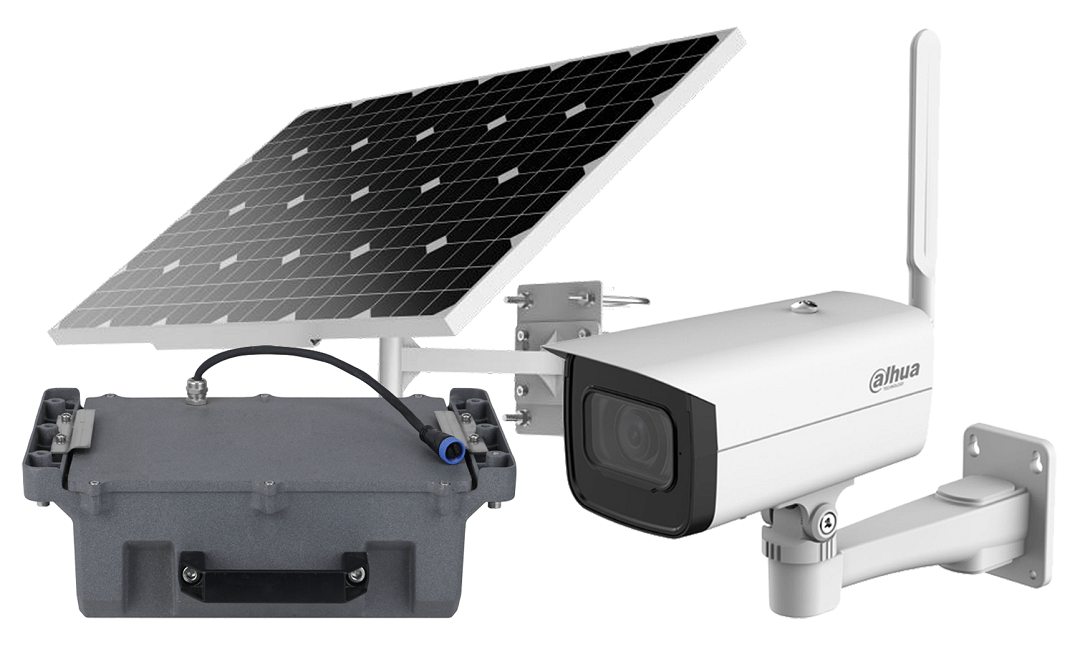
Providing visuals are Dahua’s 2MP WizSense 4G network camera with a ½.8-inch sensor, IP67 protection against dust and water, a smart codec delivering H.265 and H.264 compression, along with smart motion detection technology.
Integrated intelligent detection includes intrusion, tripwire (supporting the classification and accurate detection of vehicle and human), while abnormality detection covers motion detection, privacy masking, no SD card, SD card full, SD card error, network disconnection, IP conflict, and illegal access. There are also 2 alarm I/Os, and an audio I/O, as well as 256GB MicroSD card support.
Setting Up
We tested the Dahua solar solution in a rural application with limited power and comms options – during the course of our test we used a local LAN, as well as Vodafone 4G. Downloading Dahua’s iDMSS app to iPhone was a simple process and with that done you scan the camera QR code within the app to find the camera over the 4G network and once that’s done, you’re away.
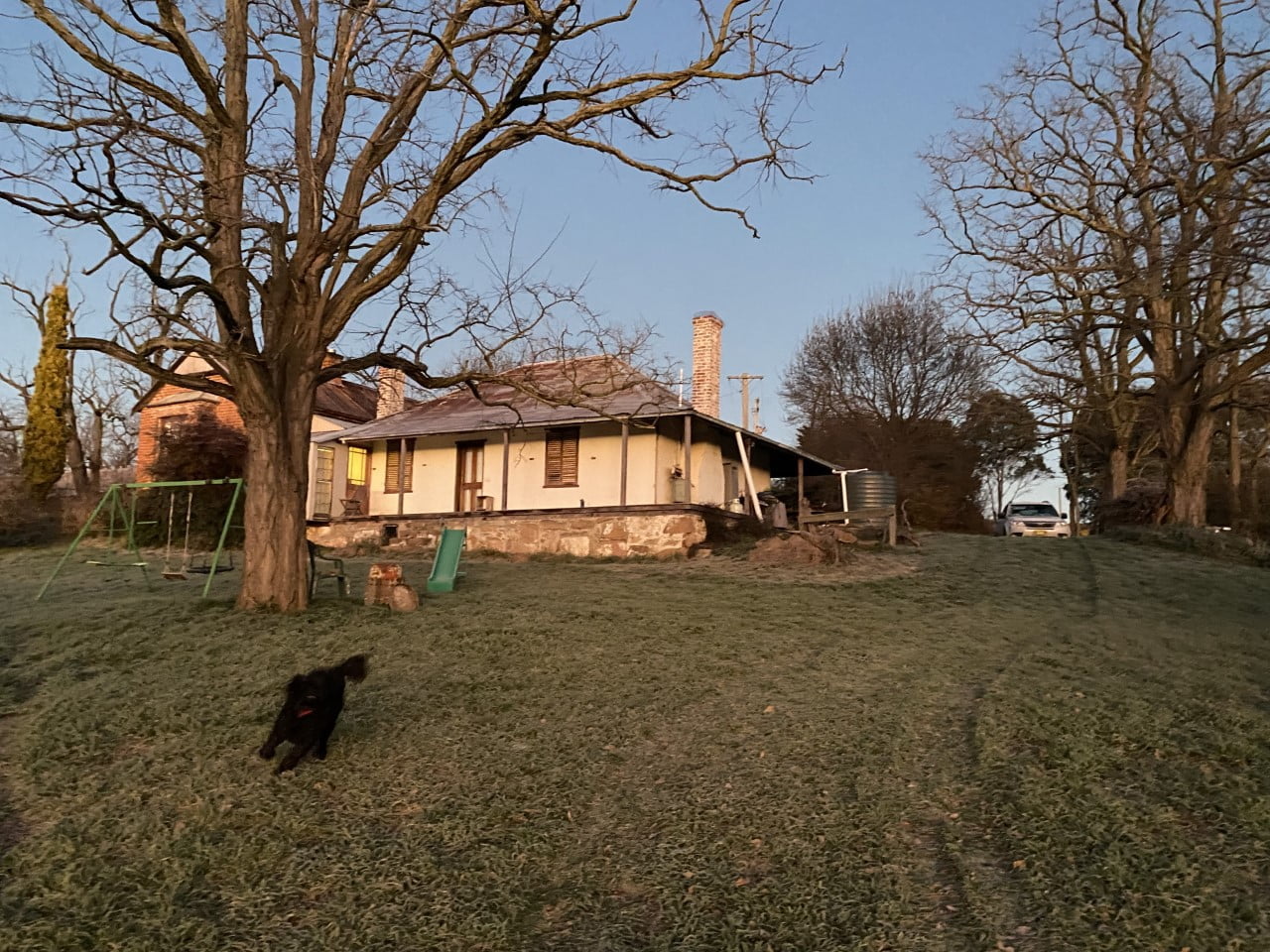
iDMSS is a simple interface that’s ideal for remote monitoring. You drill though the home screen to a 4/9/16-way camera split and a double tap on a screen brings the camera up in ‘full screen’. Controls for snapshot, audio and SD or cloud video recording options are ready to hand. I also spent some time accessing the camera from a laptop – tweaking setup was easy.
The Dahua solar camera is an integrated unit comprising camera, battery, MPPT controller and solar panel all on a single mounting bracket. I find the unit relatively heavy and cumbersome to physically manage by myself. Weighing more than 15kg when complete, it needs to be mounted on a strong upright support – there are more than adequate fittings in the box to handle this.
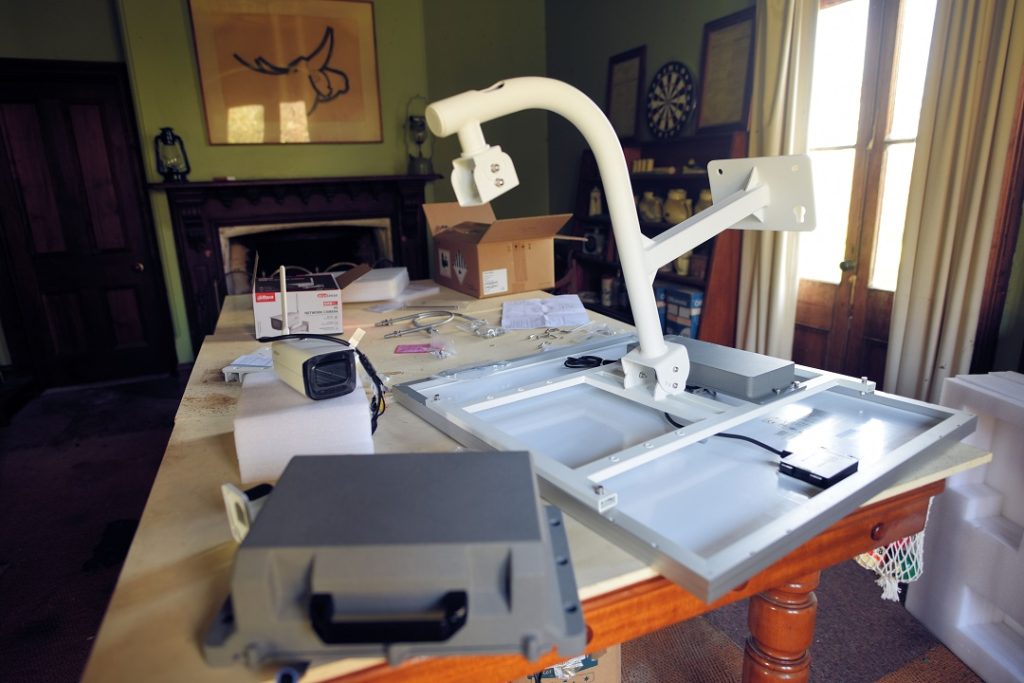
The Dahua Solar camera is a system by itself, requiring no cabling to the network and no cabling for power. This means that wherever you point it, you have surveillance through that angle of view. You can mount it on a pole, a tree, place it on a structure. I use anything I can find – chairs, water tanks, tree stumps, gate posts, an elevated deck, the ground, a ladder and the fork of a tree to get angles of view that suit me.
Something worth noting is this solar camera has an upgraded battery. Along with its MPPT controller, this delivers a surprisingly long battery life of more than a week, depending on how often you dial in for images. During the recent rainy weather, I found that with the camera and solar panel located in a shaded position behind tall trees, the battery ran out and I lost the image stream.
This was down to a thoughtless application – after moving the unit to an area with sunlight I found that even in rainy conditions, the system managed to continue to deliver live video whenever required. It only takes a couple of hours for the solar panel and MPPT controller to charge the battery fully – that means a brief period of direct sun each day is enough to give you many days of video surveillance in a remote application.
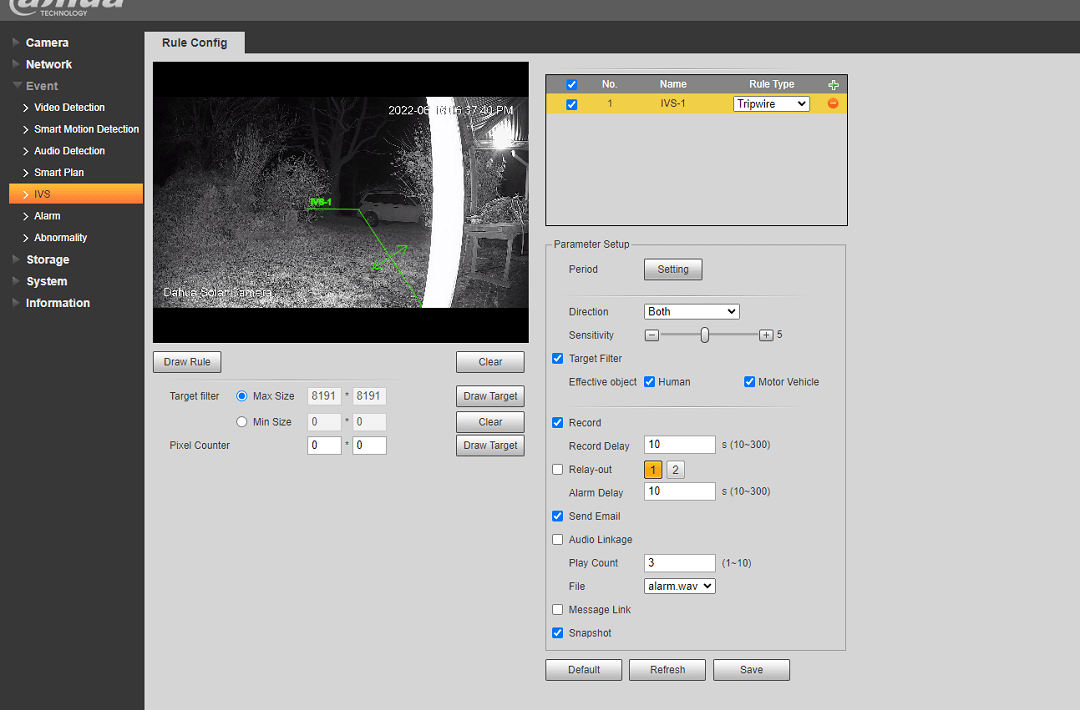
The flexibility of this 4G solution is such that you really can monitor the camera from anywhere at all via your phone or tablet. I found myself monitoring the property while travelling at 100kmph an hour in the car via the Vodafone 4G network, which, according to Dahua, offers the best performance characteristics for this solution. Neat, too, I had no trouble once the camera was set up connecting and viewing. I monitored the camera from bed. From a movie theatre. While sailing. Wherever.
There’s something delightful about a robust CCTV solution that can be positioned anywhere you need it, which will continue to deliver useful images no matter the weather conditions, no matter the time, no matter where you are in the world. To be able to tap an app on your home screen and be viewing a location in good resolution, with an IR-supported monochrome image stream for night work is downright cool.
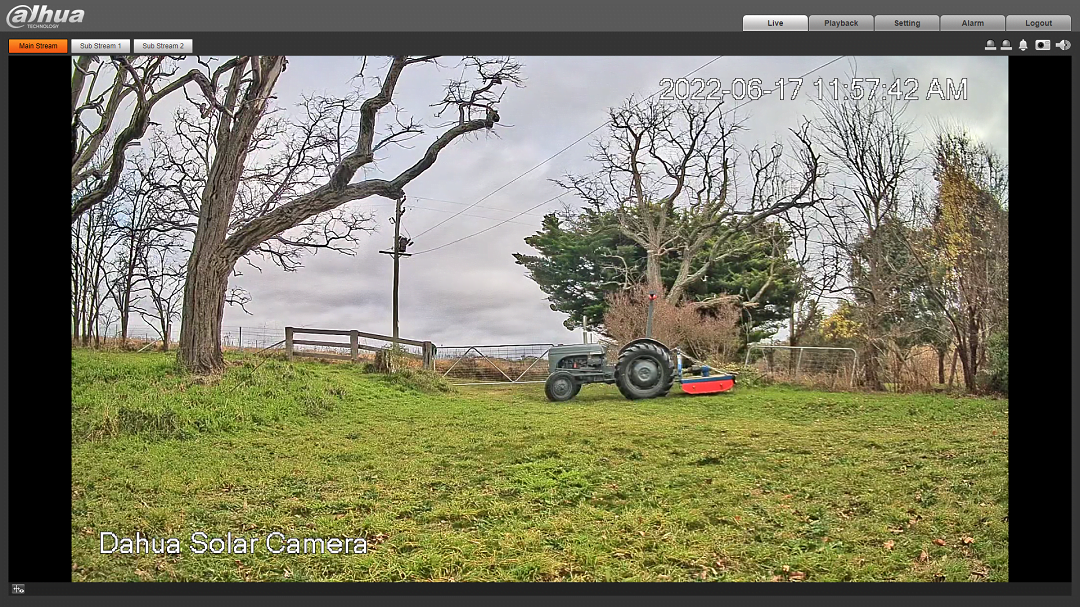
This camera has 2MP resolution and while I viewed the camera in 2MP when connected to my laptop via the local network and directly connected blue cable, once I started to use 4G I had 3 resolution options – D1, VGA and CIF. I selected D1 – that’s 704 x 576 pixels in case you’ve forgotten. I opted to stick with the default H.265 compression and left the camera at 25 frames per second.
My bit rate setting was CBR with a maximum of 512 per second, which is low. Given my SIM card maxes out at 50 GB per month, I didn’t want to overstep the mark in that regard, but I needn’t have worried. What blew me away about this configuration was how useful it was and how little bandwidth it used.
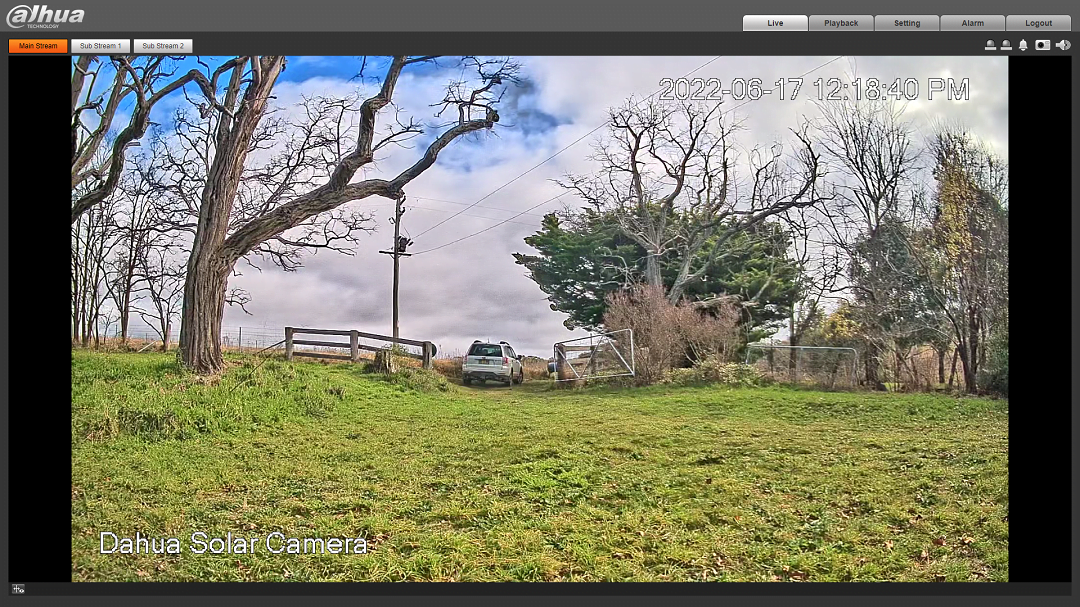
When it came to motion detection, I opted for an advanced configuration with a 5 second anti-dither and a sensitivity of 60. I selected constant video detection and hopped into mask settings and covered the entire scene. The sorts of application this camera is going to find itself include viewing of entry points, structures, or areas and objects of importance to a depth of field of about 25 metres.
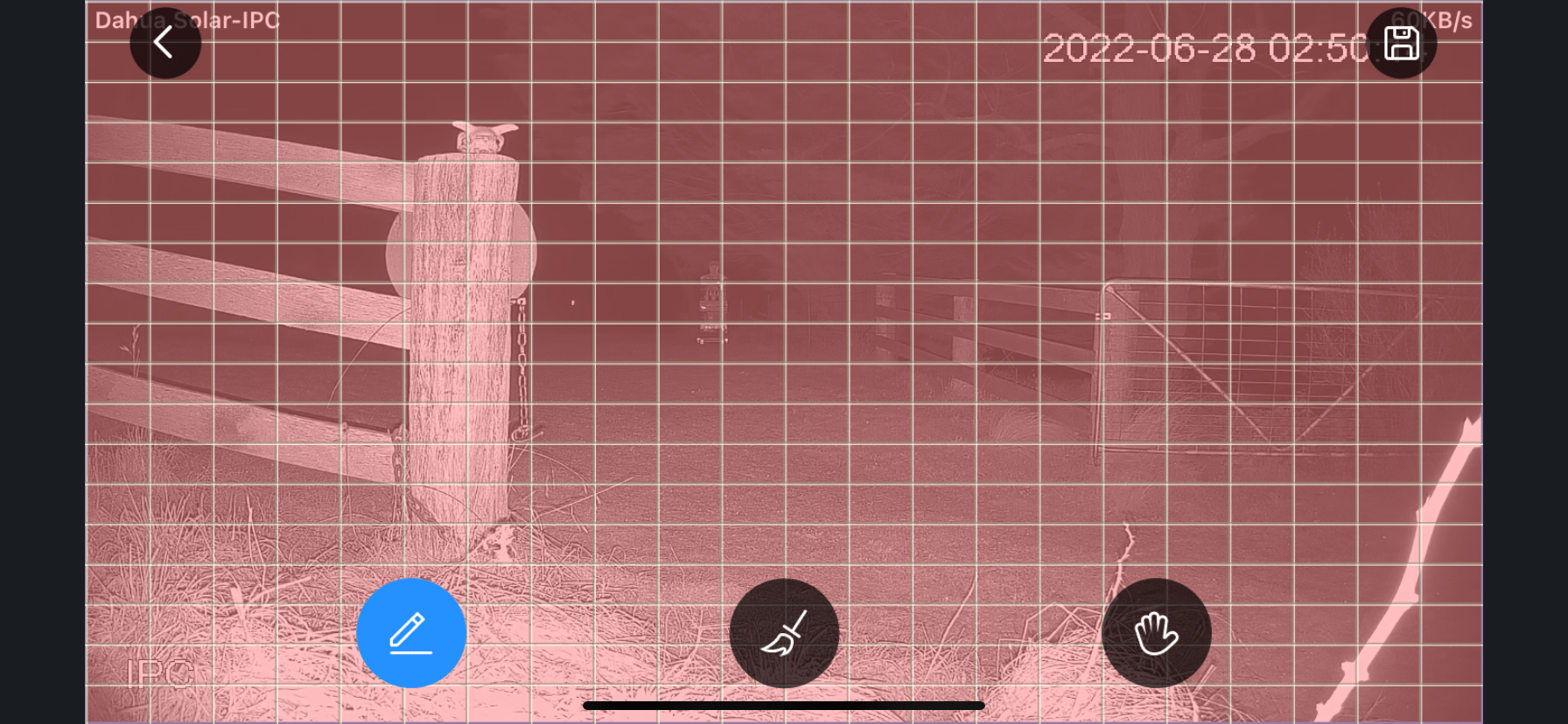
Gates and buildings were the subjects I selected for viewing in my application – I was also eager to keep an eye on whether or not the neighbours wicked cattle broke through the fence again and took their usual liberties.
Test Driving Dahua Solar
Looking at the images on the iPhone screen I found resolution fine for portrait or landscape view, even though the bit rate almost never exceeded 200kbps. From the start I’m happy with the level of detail I’m getting with the gate around 25 metres from the lens. I decide early on that 25 metres is about the maximum distance I’d want to challenge this 2MP camera in a security application. In weak sunlight I find colour rendition to be good, though I can see plenty of chromatic aberrations – longitudinal and latitudinal, suggesting the lens could use a re-design.
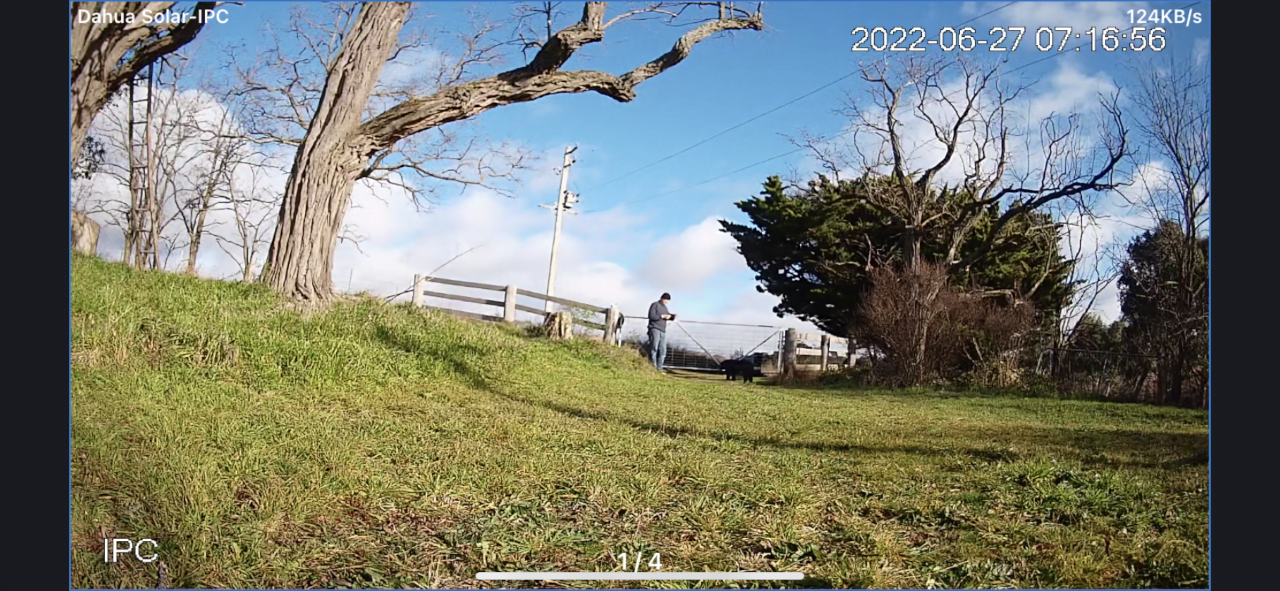
The focal point arrives early, it’s less than half a metre deep and at this resolution the sweet spot tends to be closer in – within 10 metres of the lens by my reckoning. Past that distance, pixel spread starts to weigh on detail. Regardless, it’s an easy matter to recognize an individual within that depth of field and there’s no shortage of detail of clothing, colour of vehicles, details of carried items. Even at low-resolution faces are very nearly court admissible. I find performance against strong backlight with WDR activated to be good. There is a little overexposure in the sky, which is to be expected when significant areas of the scene are shaded.
I move the camera closer to the gate. The lens is about 2 metres from the gate post. This position gives me a full view of the drive all the way to the road – it’s around 45-50 metres. Again, I note good colour rendition. Images tend to be soft, but I still have reasonably good depth of field. And although I don’t manage to capture them while sitting inside (I can’t tap fast enough), I’m able to view traffic whizzing past on the road.
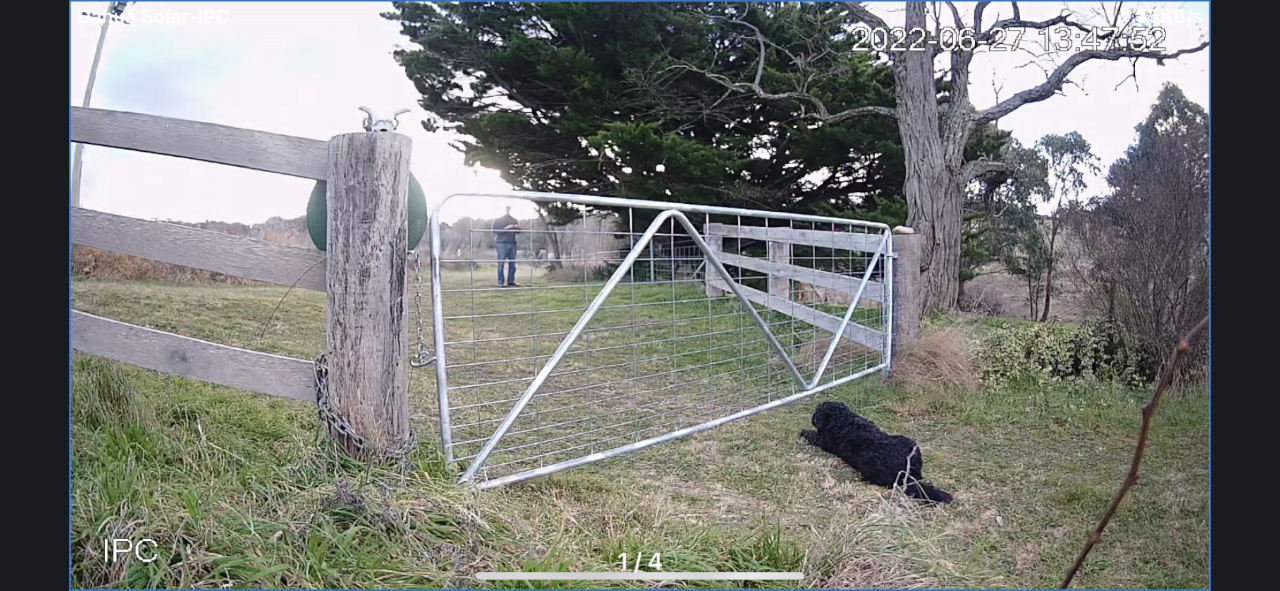
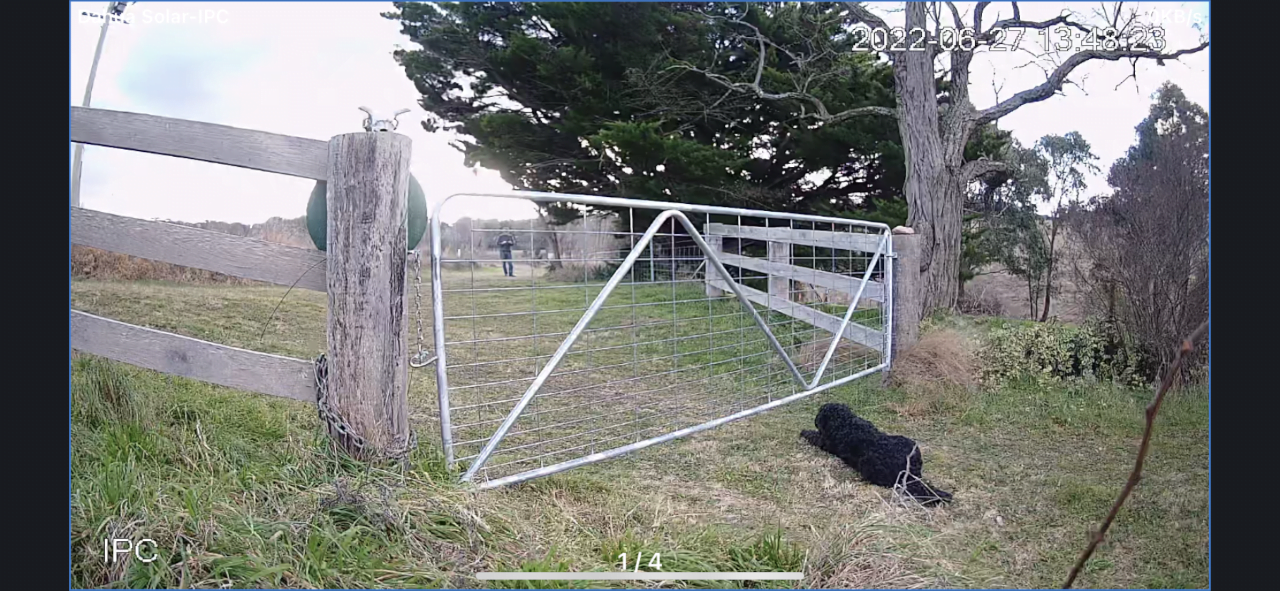
I undertake a test with myself as the target to see at what point useful identification is lost. Close in I have face recognition. At around about 12 metres with strong light behind there’s no chance of seeing my face but all other particulars are clear. Detail thins out at 25 metres but is still useful. At 35 metres you can see clothing colour, skin tone and hair colour, but detail is further reduced. At 40 metres it’s reduced again but I can tell that I’m a white guy with mostly brown hair wearing blue jeans and a blue jumper.
Were a vehicle to pull into the driveway 40-plus metres from the lens I would have no trouble identifying colour and vehicle type – I can even see a neighbouring house in the distance – about 500 metres from the lens. The detail is soft but major events like fire would be readily discernible.
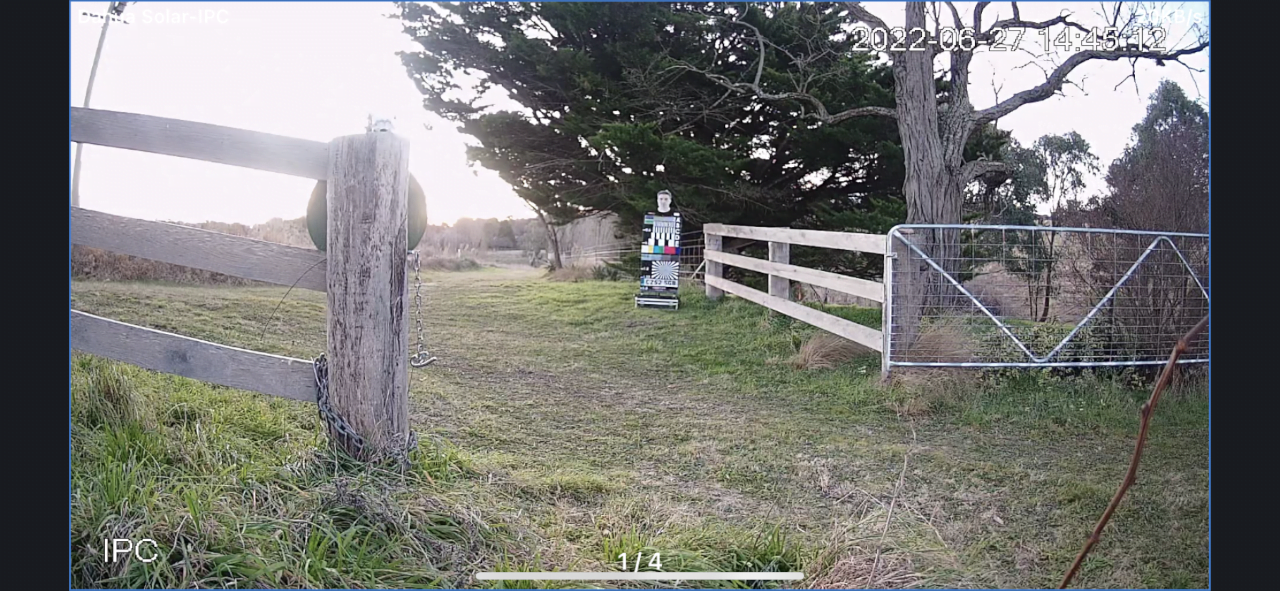
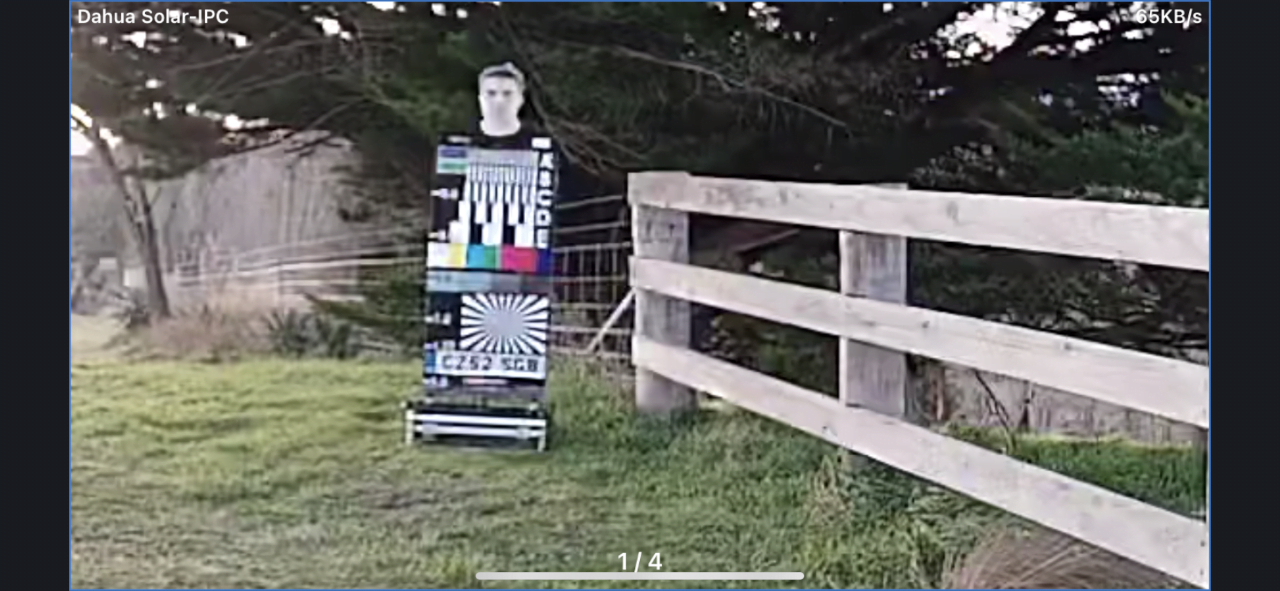
I then haul Norman up to the gate and position him 10 metres from the lens. At this distance I have his plate. Sharpness is reduced to the point I don’t have the A line or the B line, but I have the C line. This softness in the image is down to pixel spread, a characteristic that defines low resolution, low bitrate image streams. There’s a lot of backlight in this scene, with the sun dropping to the horizon directly in the frame. The camera handles it well, continuing to give good colour rendition and plenty of detail, especially closer in from around half a metre through to 10 metres. I can see grass stems, the texture of wood in the gate post and more.
Zooming in digitally I confirm the plate and Norman’s face is identifiable. Zooming clarifies I have the C line and nearly the B line but not the A line, but detail is good considering these images are coming through at a measly 65 kilobits per second even with branches and grass moving. As the sun drops lower, images seem to sharpen up again, particularly close in, with a lot of detail and sharpness around grass blades and differences in colour tone. There’s some barrel distortion evident at the edges, but it’s not too extravagant – perhaps 8 per cent.
Situational Awareness
Later in the evening I head out with myself as the target to get a sense of detail and motion blur. Situational awareness at the gate is solid. There’s no problem whatever detecting a person is present 25 metres from the lens. As I approach the camera levels of detail increase significantly, I’m able to see attire, footwear, carried items at around 5 metres from the lens at which distance the IR LEDs are not all that obvious to the uninitiated. I get a solid image of myself (perhaps a little too solid) that would unquestionably be admissible. Motion blur is present but reasonable, considering.
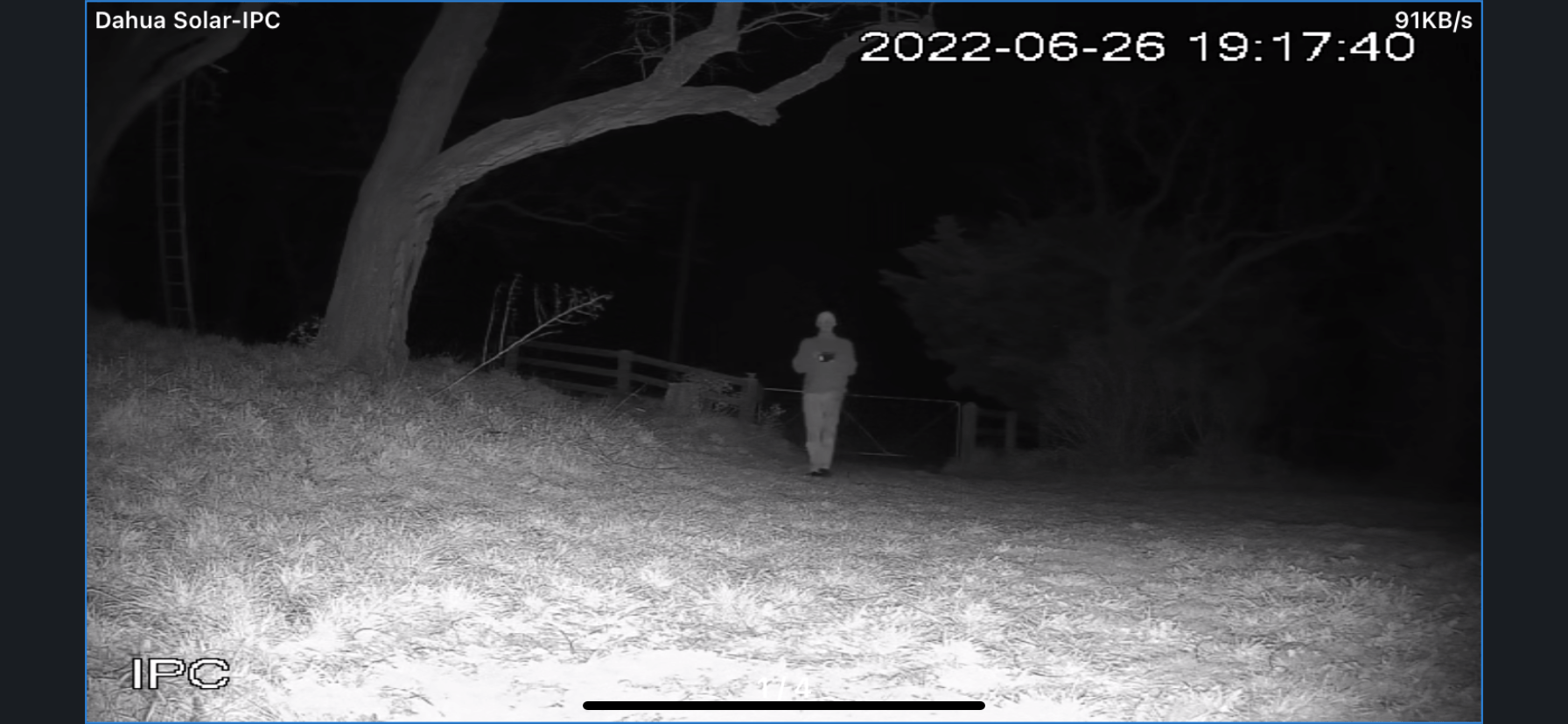
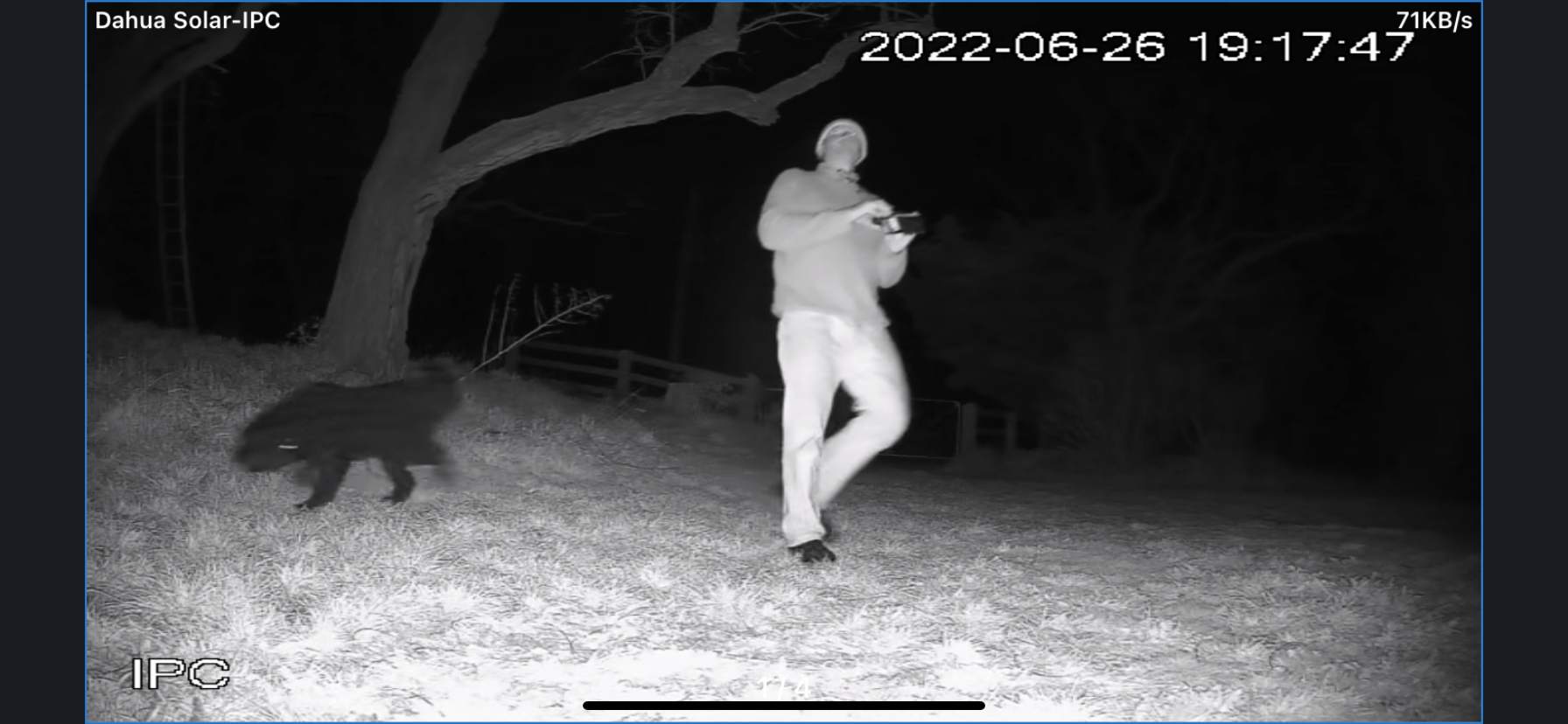
With Norman 10 metres from the lens and IR activated detail is excellent. This is a static scene and despite a bit rate of 19 kilobits per second I’m very happy with the image. No, it’s not a moving plate but in remote applications where response is going to be a process and bitrate is king, getting good detail from a parked vehicle or an intruder standing still have big value.
Still, I’m surprised to see detail pushing out past Norman. Looking at this scene I feel my sense that effective reach is around 20 metres was accurate. Again, I’m impressed with the spread of the IR array. It goes edge-to-edge and with objects in the foreground I’m pleased to see that flare is minimal.
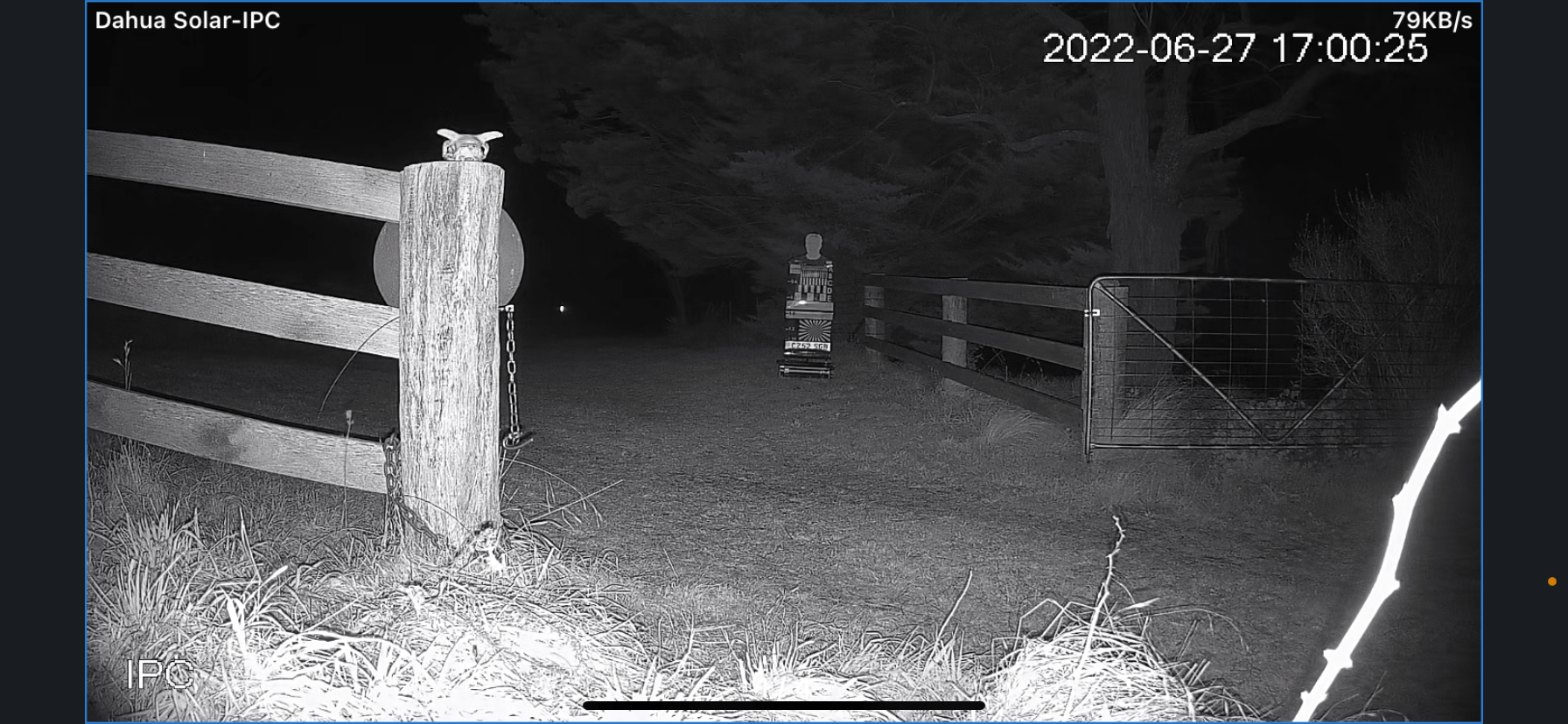
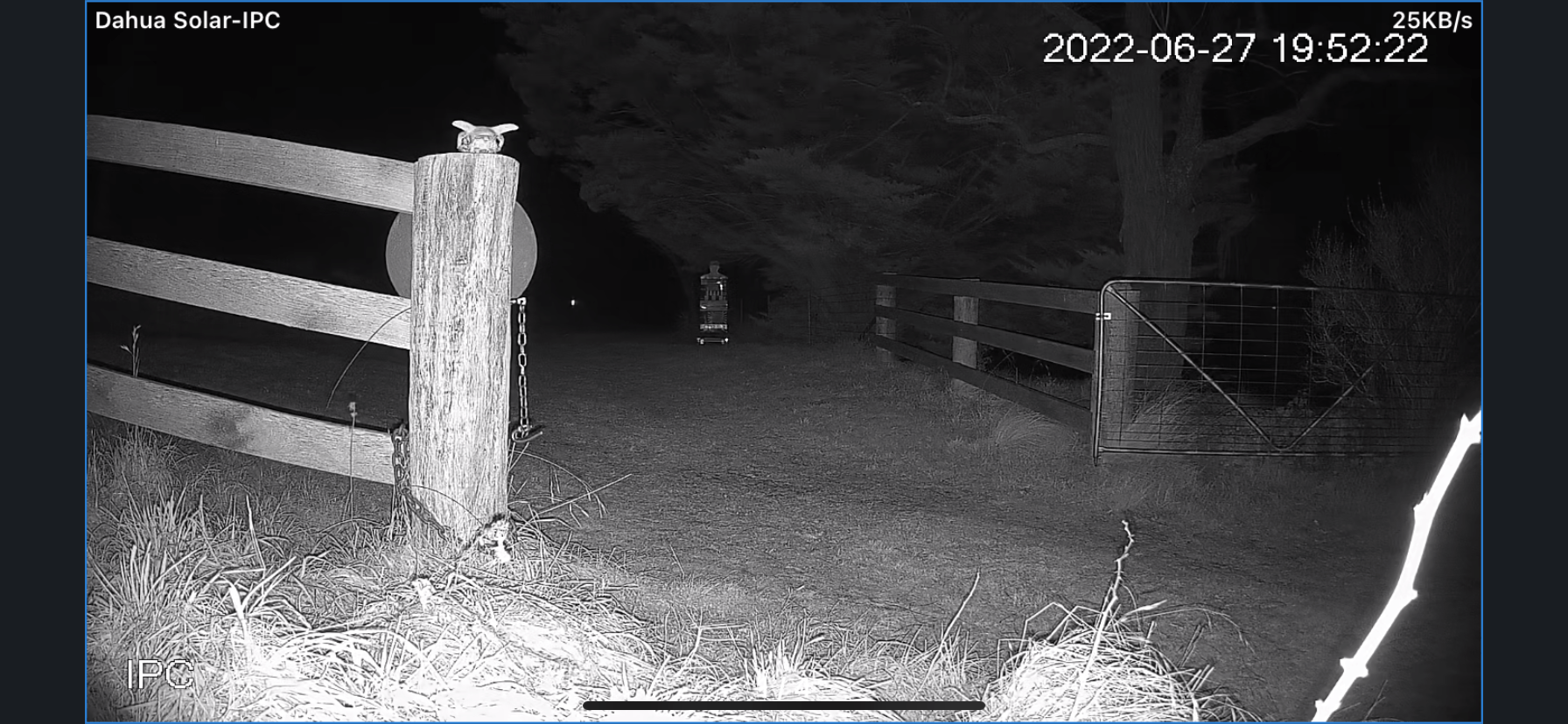
My next test is with a vehicle driving through the gate at night with headlights on – after a clear night it’s a very cold early morning at 800 metres and I read -7C on the temperature gauge. The Dahua camera doesn’t care. Positioning the car, I find with high beams on there’s flare and blooming. This is unsurprising given the predominantly dark areas of the scene are slowing shutter speed. Something else to consider is my camera location – it’s in line with the car at around 1.2 metres – near headlight height.
Once the headlights are at an oblique angle, I have complete situational awareness around the vehicle and around the gate – something to note is that with headlights and taillights in the scene the camera has hopped into colour mode even with sub 2 lux at the lens.
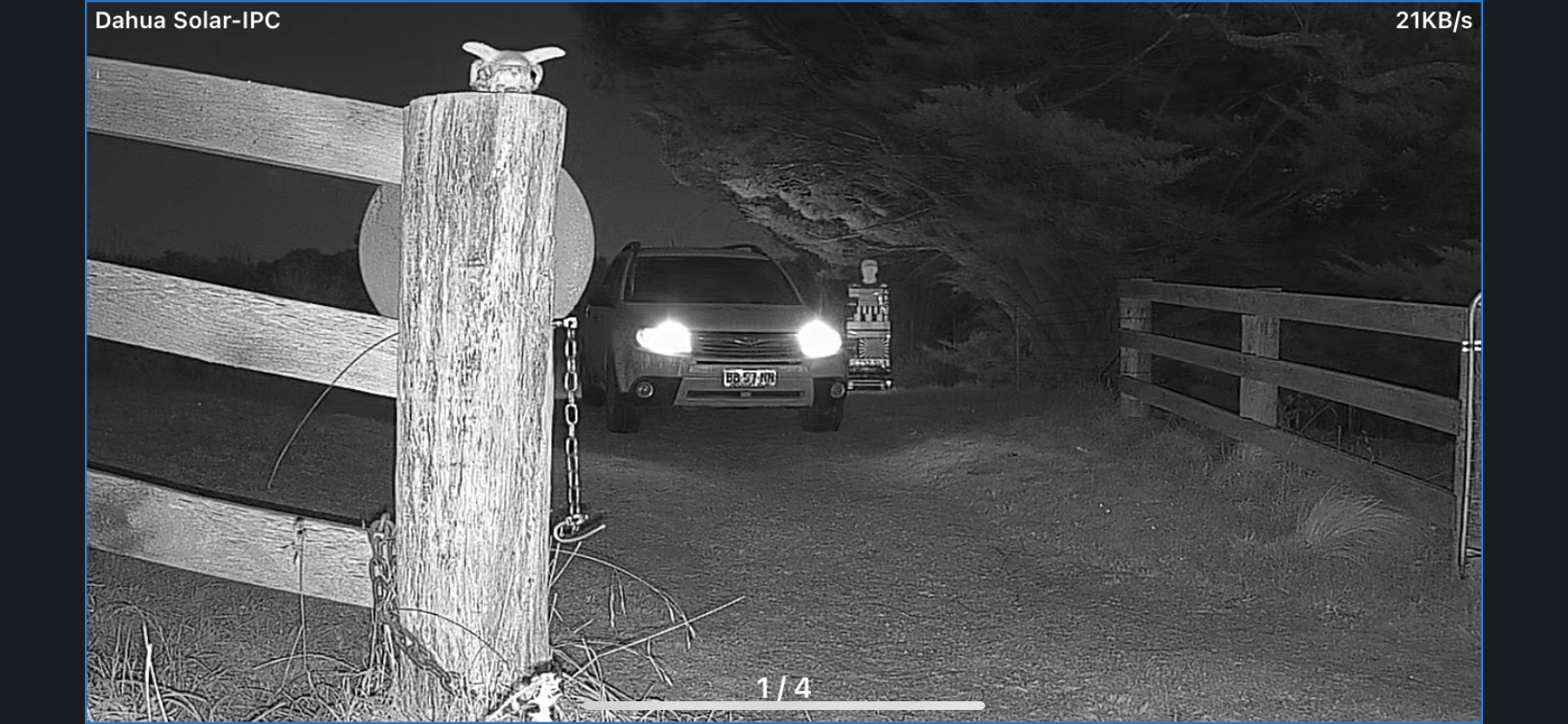

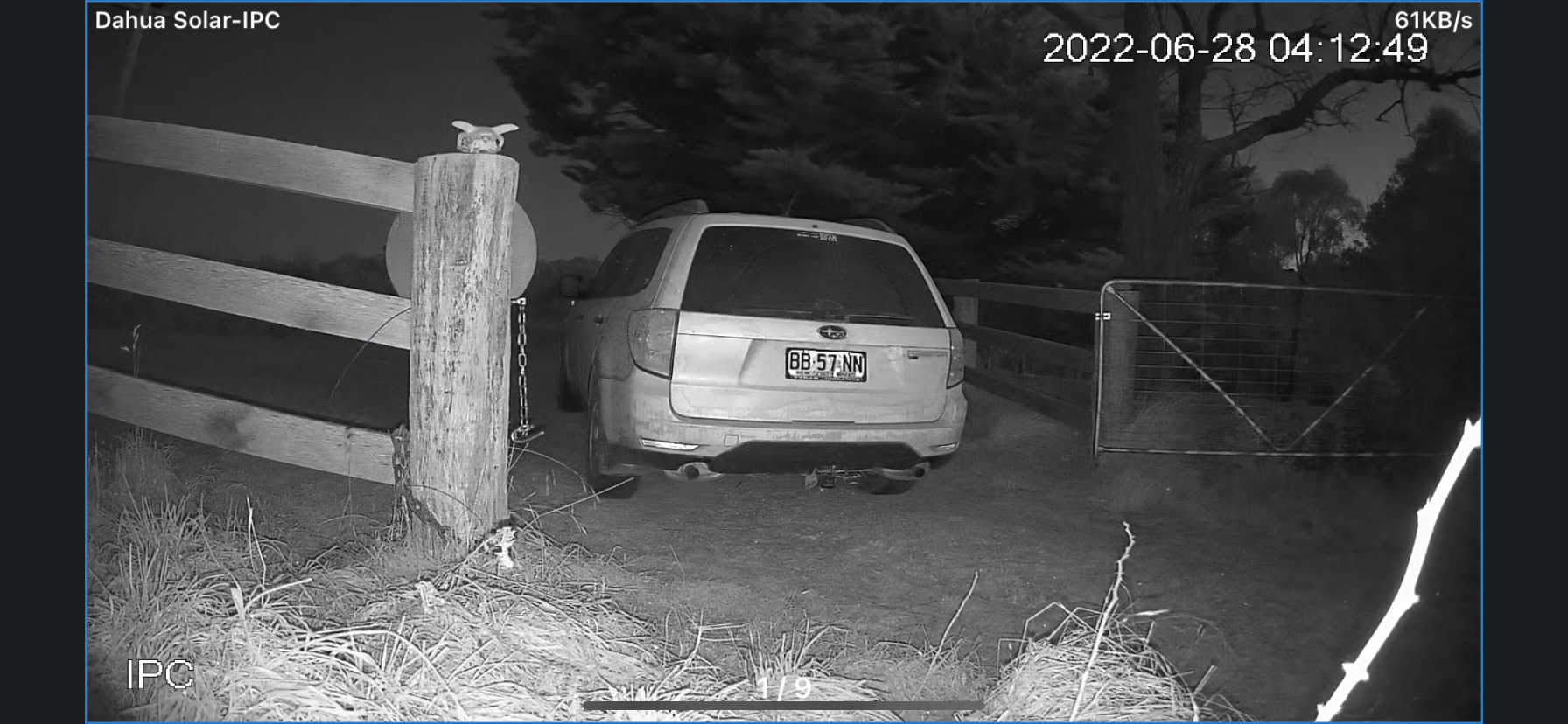
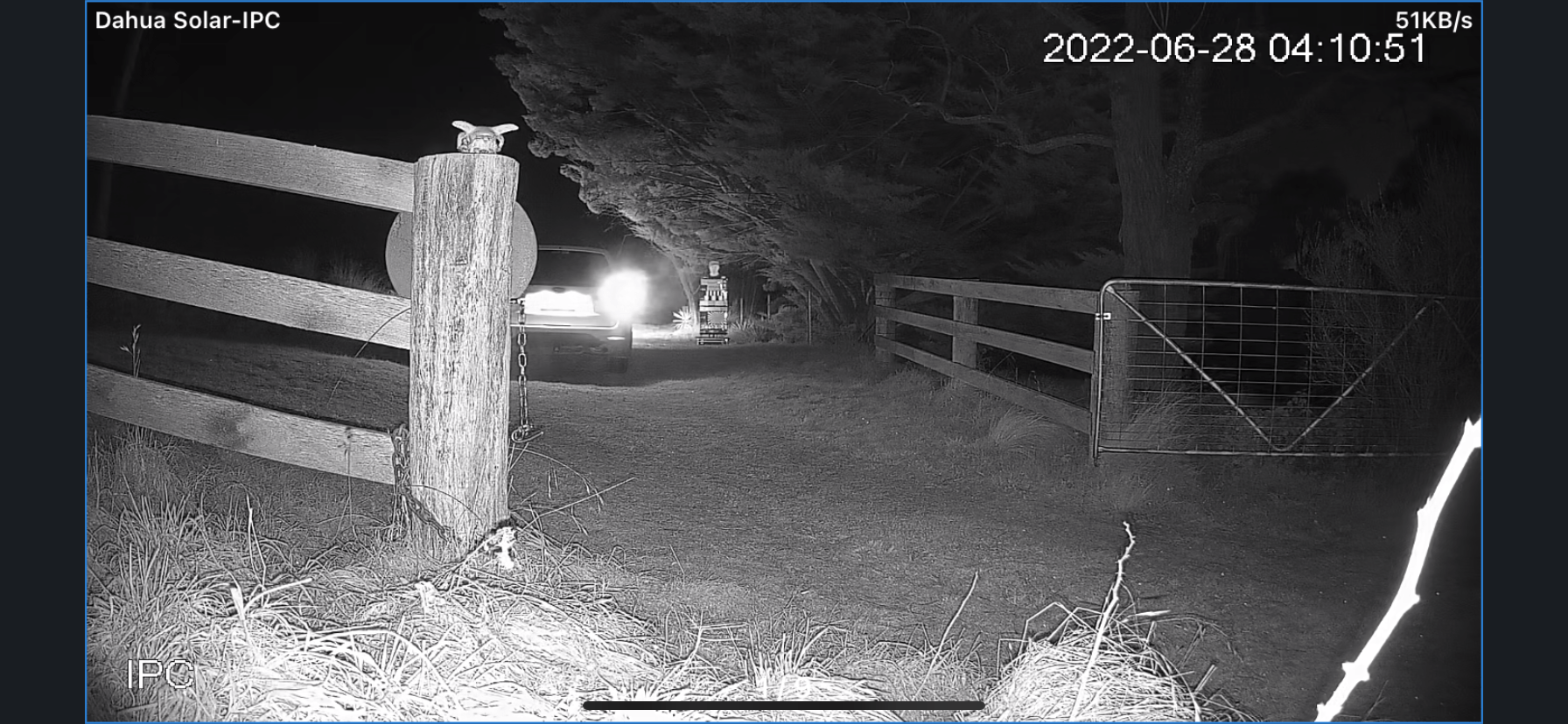
Next, I drive the car out with the headlights and tail lights on. I have some veiling flare or blooming of the sensor with the brake lights on. I don’t get a plate in those circumstances, but it’s pretty clear to see the vehicle is a more than usually grubby off-white Subaru Forester. With headlights dishing up ambient light it’s almost possible to see Norman’s license plate at 20 metres with the car simply driving out of the driveway.
When I undertake this manoeuvre with lights off I get a crystal clear plate in the sweet spot at around 5 metres from the lens (top image). The scene shows almost no motion blur, though I was in low range first and going slowly. With the car parked 22 metres from the lens I’ve lost the plate but have no trouble recognizing the vehicle make and model.
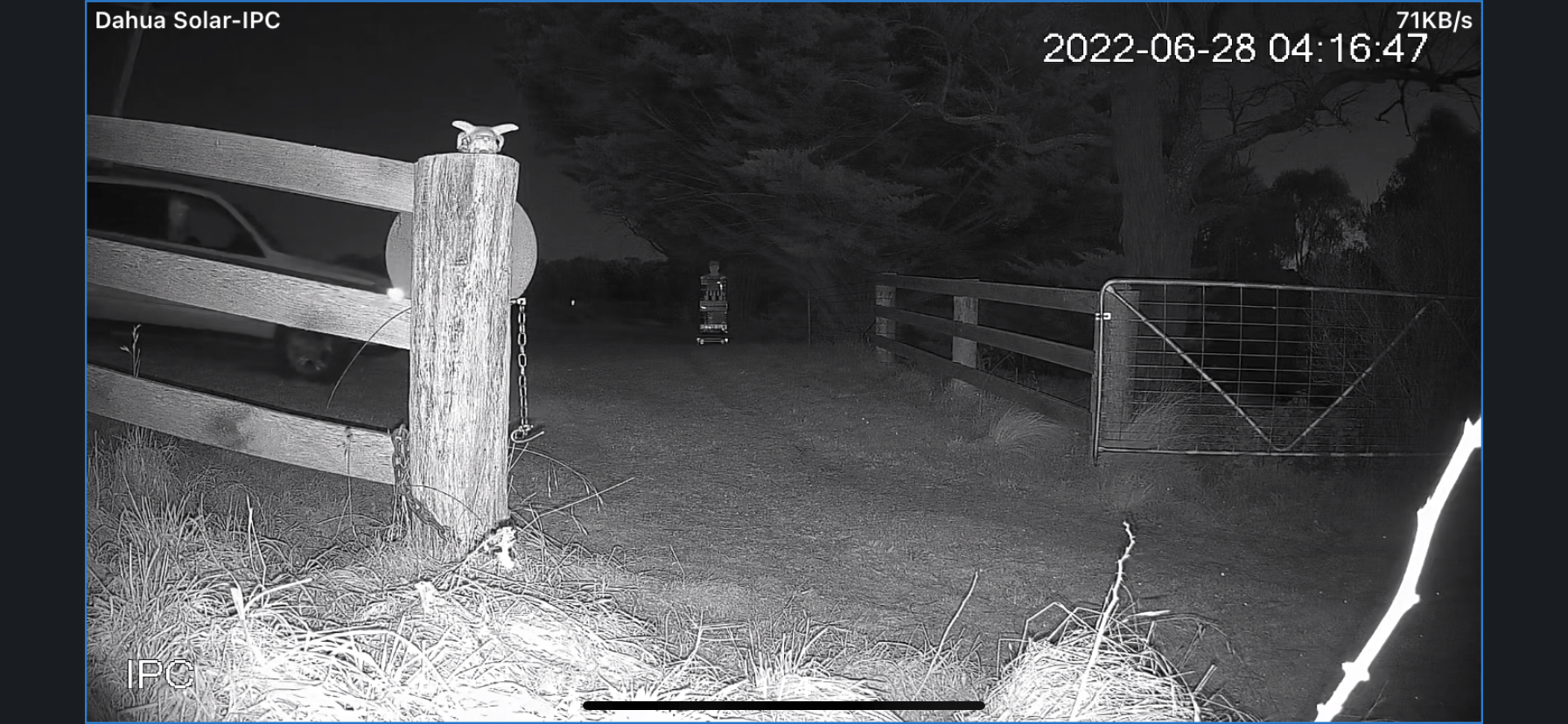
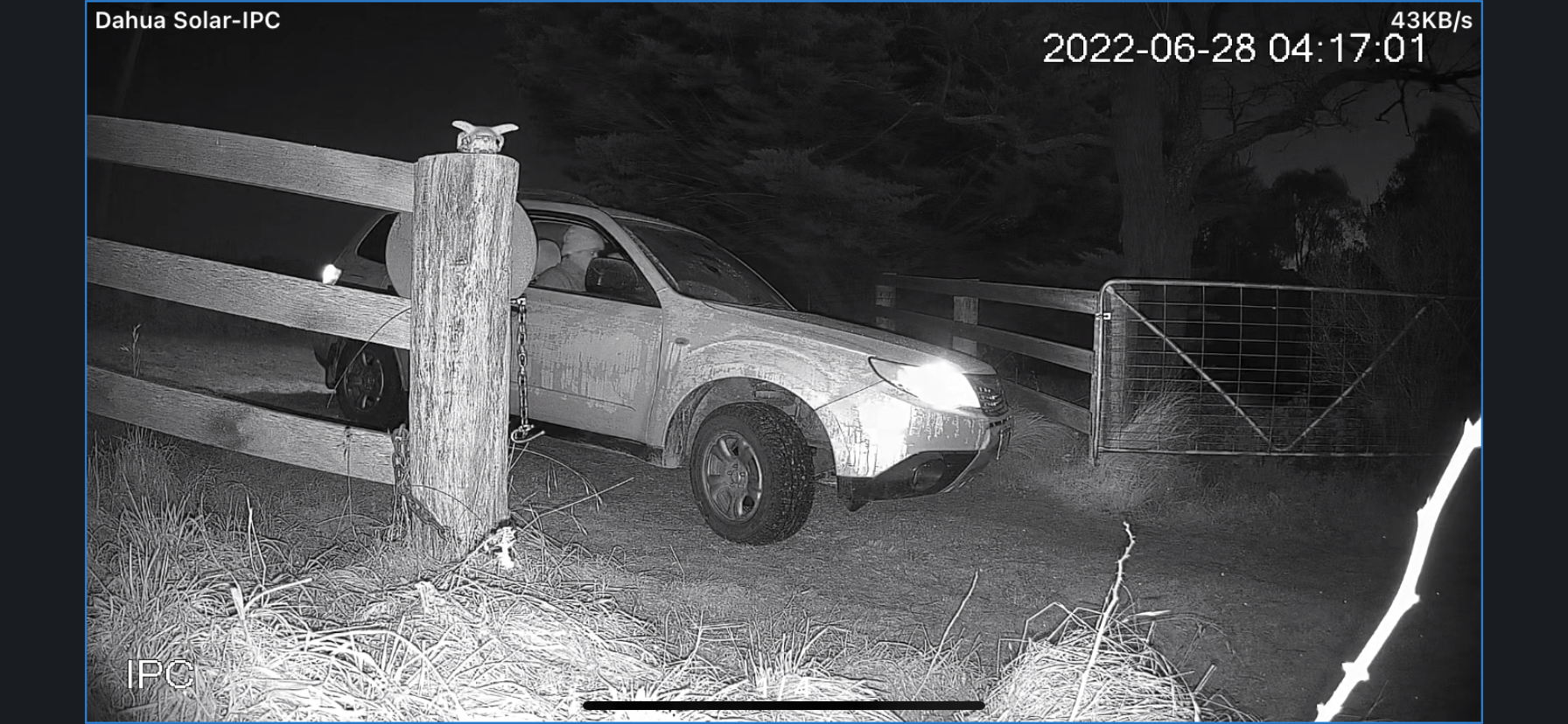
Turning around I drive past the gate from the other direction at about 7-8 metres from the lens. Again, I can see sufficient detail even while moving to recognize the vehicle from its profile and wheel design, as well as identifying certain characteristics of the driver – beanie and skin tone. I can see ice on the windscreen, as well as general filth all over the car from some madcap ORS adventure in Sidmouth Valley Creek.
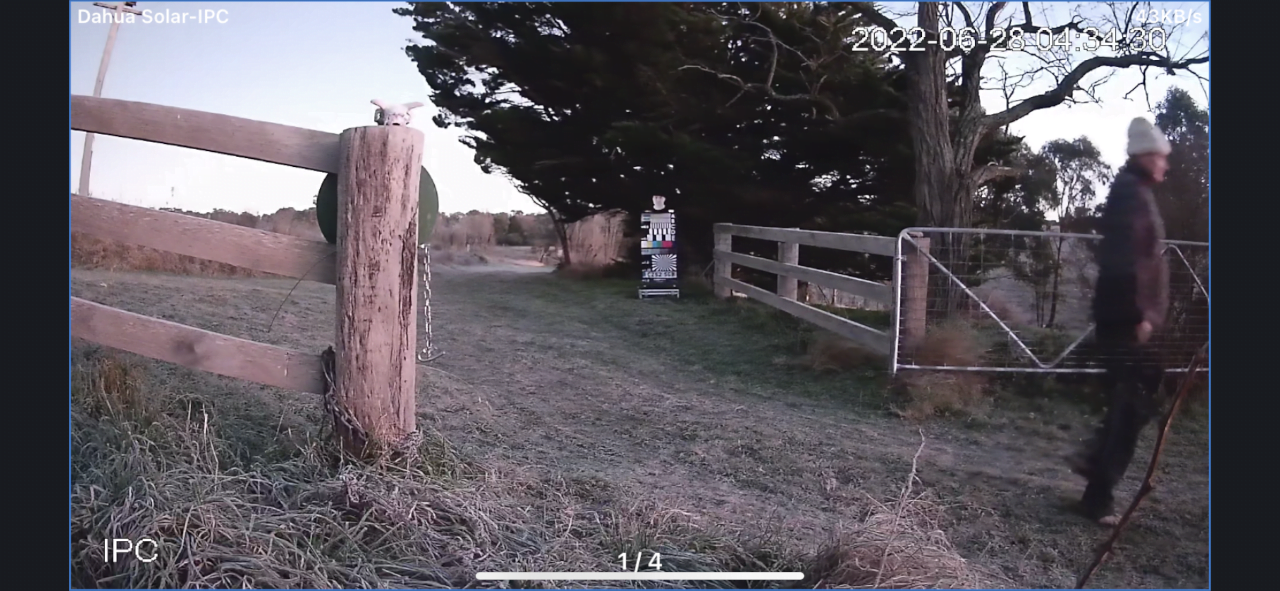
As dawn breaks, I position Norman 20 metres from the lens. I can see he’s there but don’t have a high level of detail. Still, situational awareness is good. Closer to the gate in that 1 to 10-metre sweet spot I’ve got good detail. When car is parked 25m from the lens, the vehicle type is identifiable, but the plate is indistinct.
This is a static image and I note that it’s trickling down to my phone at a measly 18 kilobits per second. This is exactly what you want with a 4G connection where situational awareness over a long period at a sensible price is paramount. When you’re viewing a scene in 4G from a remote location it’s a balancing act and I find myself happy with the payoff.
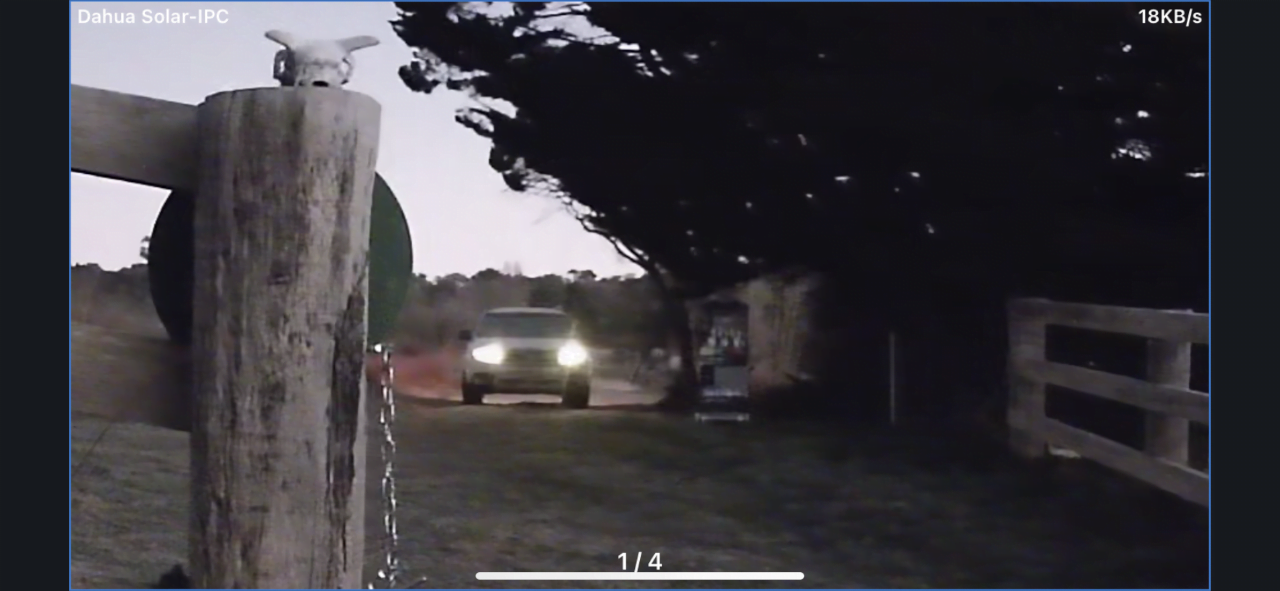
With the car at back at 10 metres from the lens and dawn in full swing (I have sub 40 Lux on the Sekonic), the camera is in colour and rendering the scene brighter than it appears to the eye. I can see the yellow and black of the New South Wales plate and nearly make out letters and numbers. Once I drive the car into that sweet spot at around 6 metres from the lens, the plate is easy to discern, as is the vehicle type, model, year.
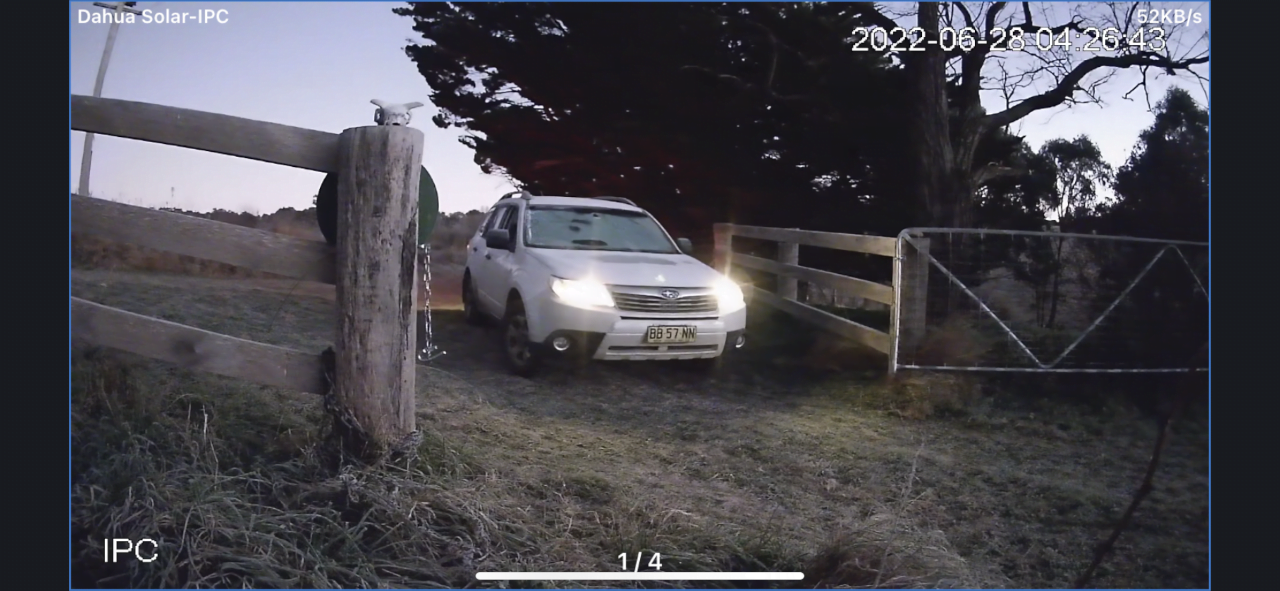
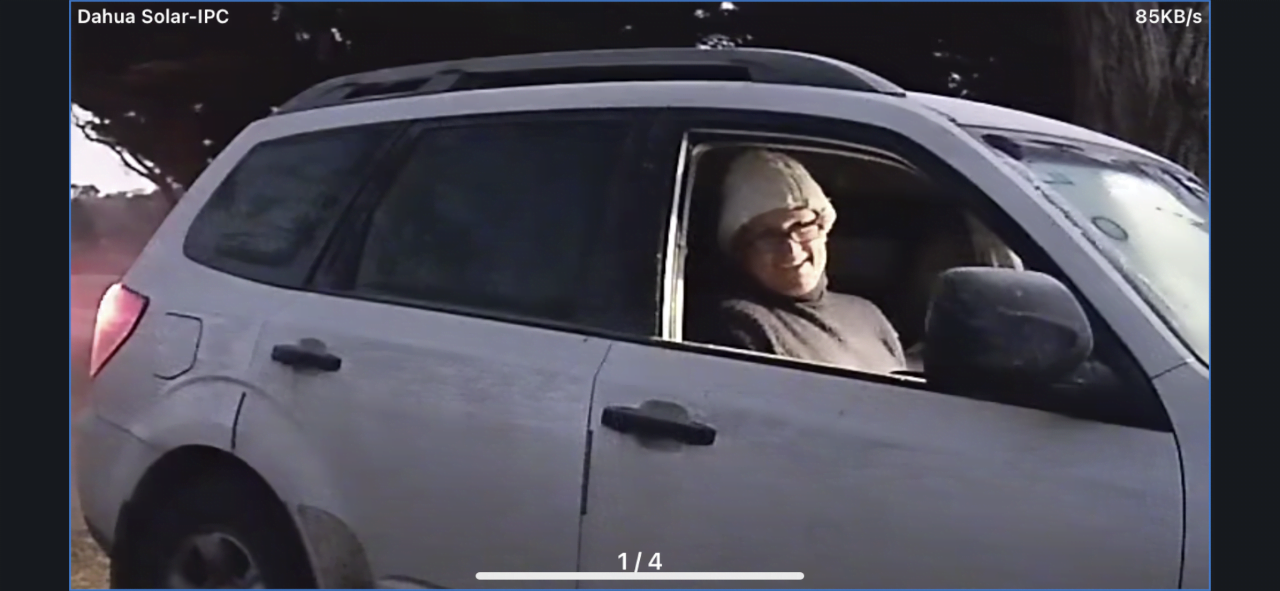
As the vehicle goes through the gate and passes at right angles to the camera, I get easy face recognition that’s certainly court admissible. Range is probably 2 metres. This may seem too easy a challenge, but most rural properties are fenced, and gates form a natural choke point, making them ideal focal points for a CCTV camera. Going through the gate I note motion blur is surprisingly well controlled and with light levels increasing, sharpness increases, too.
Wild Weather
During the day I dip in and out of the image stream. Camera performance, given the modest resolution and mellow bit rate selection, is very good at the gate and out to about 10 metres past it. There is a caveat here and that is that if you placed the camera further from the entry on the secure side of the fence, the image at the gate could soften – around 2-5 metres from the entry point is optimum for recognition and plate on approach at this focal length.
On a gloomy afternoon I move Norman to a different spot and turn the camera so it’s looking back down towards the house – he’s further from the lens now, perhaps 25 metres – I’ve lost the detail of the C line, but I have the D line. I have no plate, but if you knew Norman, you’d be able to recognize his hard man haircut.
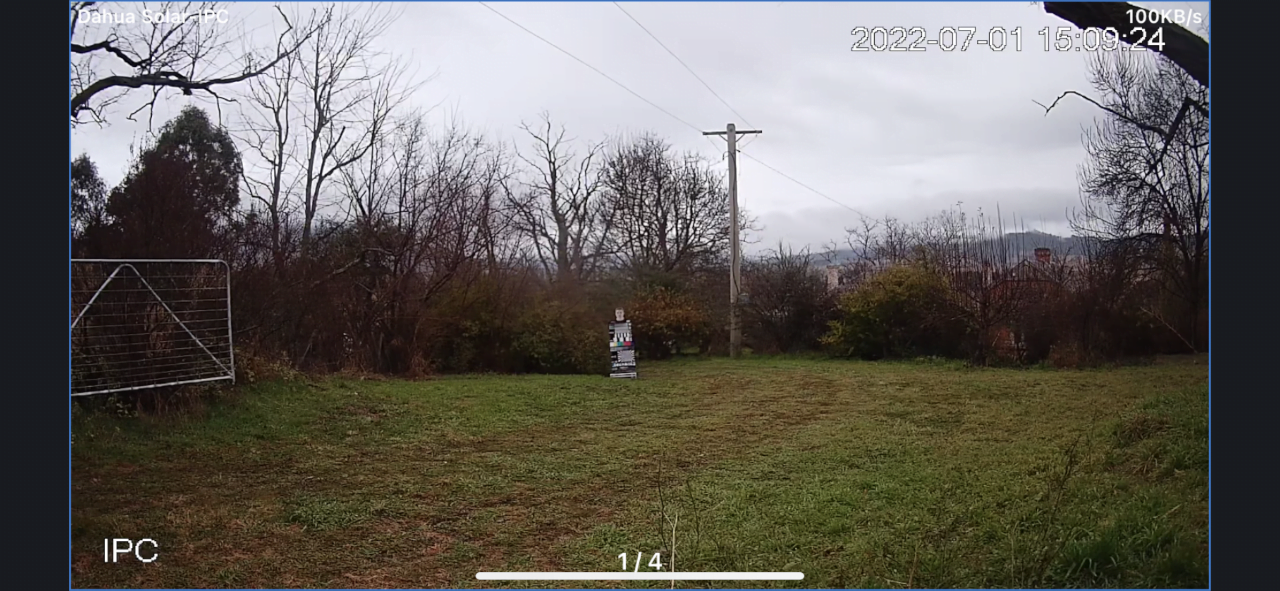
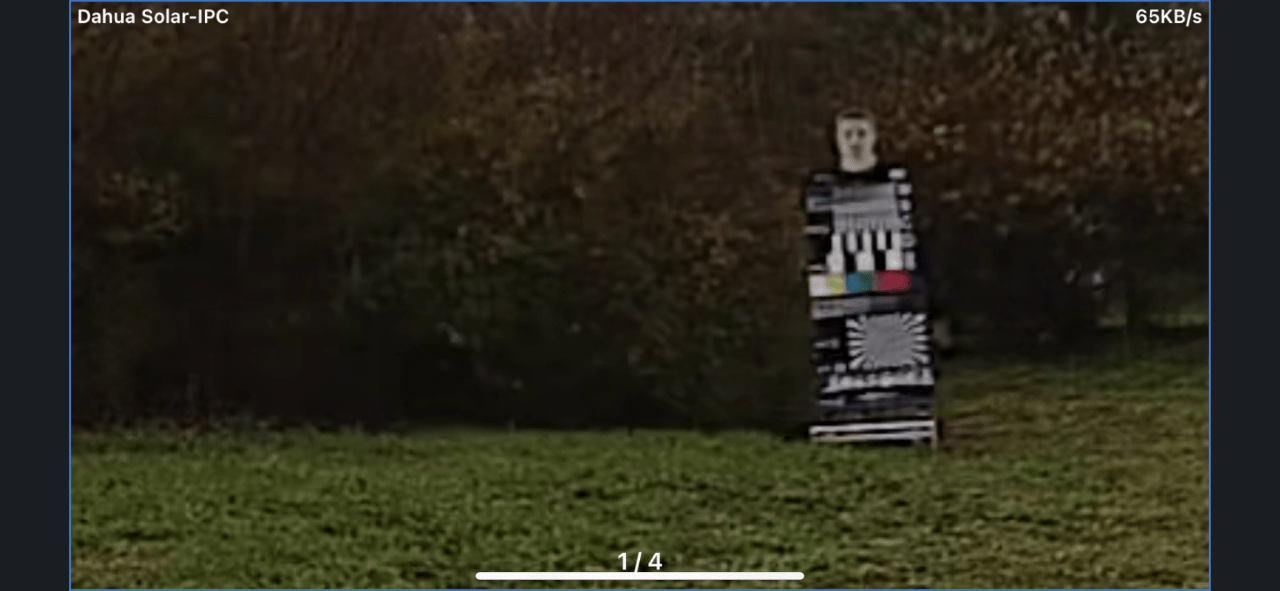
Situational awareness is solid. I’m even able to see through the branches to a distant ridge line about 3 kilometres from the lens. It’s not huge detail, but you could ascertain the presence of weather patterns or smoke from a bushfire. Something to note is that conditions during this part of the test were utterly diabolical. During the night Norman tore off his mount but the camera plodded on undaunted.
This Dahua solar camera is rated IP67 – that means it’s capable of immersion under a metre of water for 30 minutes. While we didn’t quite get to that level, I was glad of the rating – the camera copped a beating with teaming rain and howling winds, as well as freezing cold.
In this scene, which is bounded by a bank on the right-hand side and a line of trees and shrubs on the left, the distance between the lens and power pole was around 25 metres perhaps a touch further. This scene gives excellent sense of the IR performance. I have no problem seeing from one side of the scene to the other from about half a metre from the lens all the way through the scene – sufficient to recognize Norman’s presence and to see when he’s blown away.
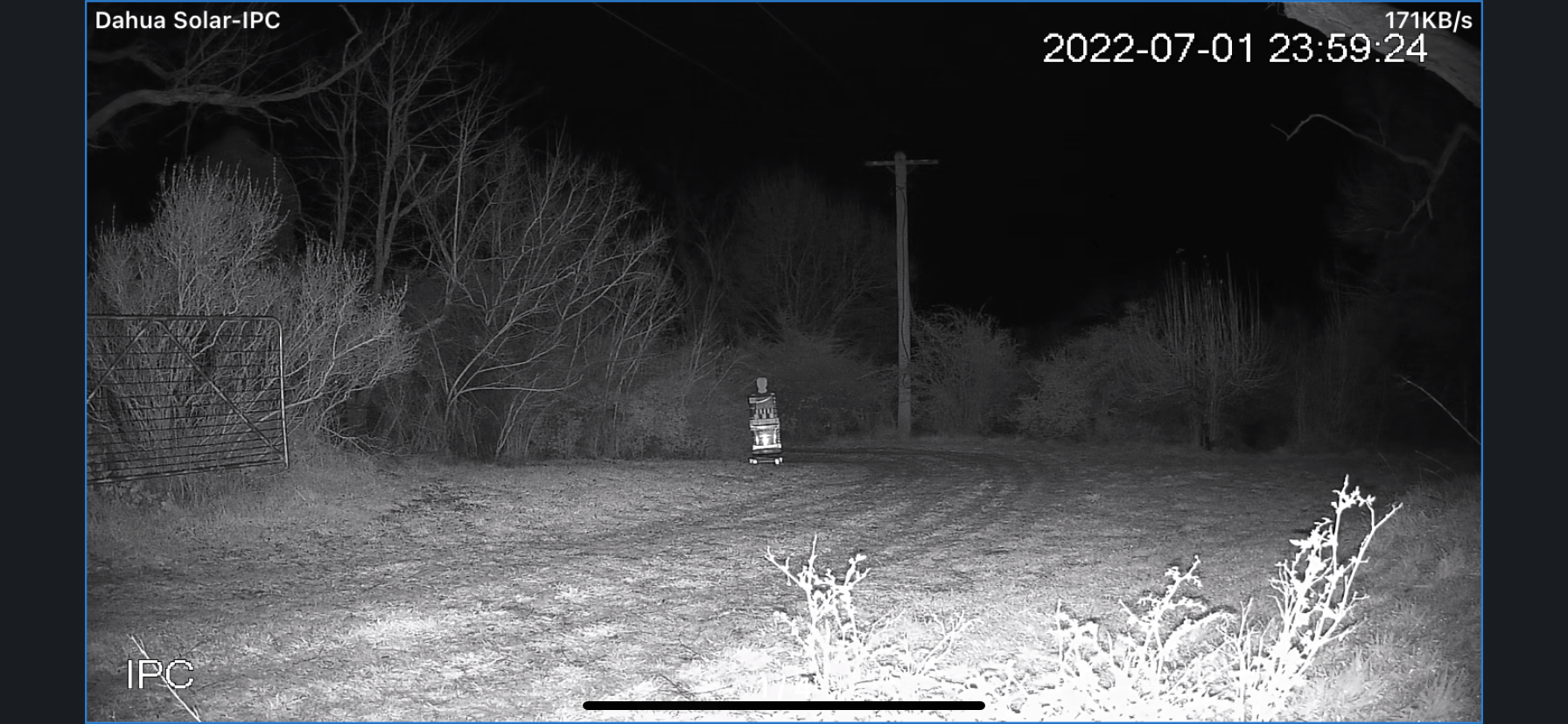

Next day, I move the camera down to view the house and undertake a day into night test. Once again, I’m surprised by the dawdling bit rate and the decent quality of images out to 20 metres. As soon as I sit down and look at the image stream, I see again the sweet spot is close in – the hyperfocal distance is probably only a couple of hundred millimetres out – the camera is doing its best work at this resolution from half a metre out to 8-10 metres from the lens.
I have excellent situational awareness of the building and there’s no chance anybody could move around it or park their vehicle in the usual spots without being detected by via camera VMD or being seen remotely. What’s left of the sun is behind the camera and as light levels fall, I notice chromatic aberration increases – it’s widespread in areas of high contrast, particularly around branches.
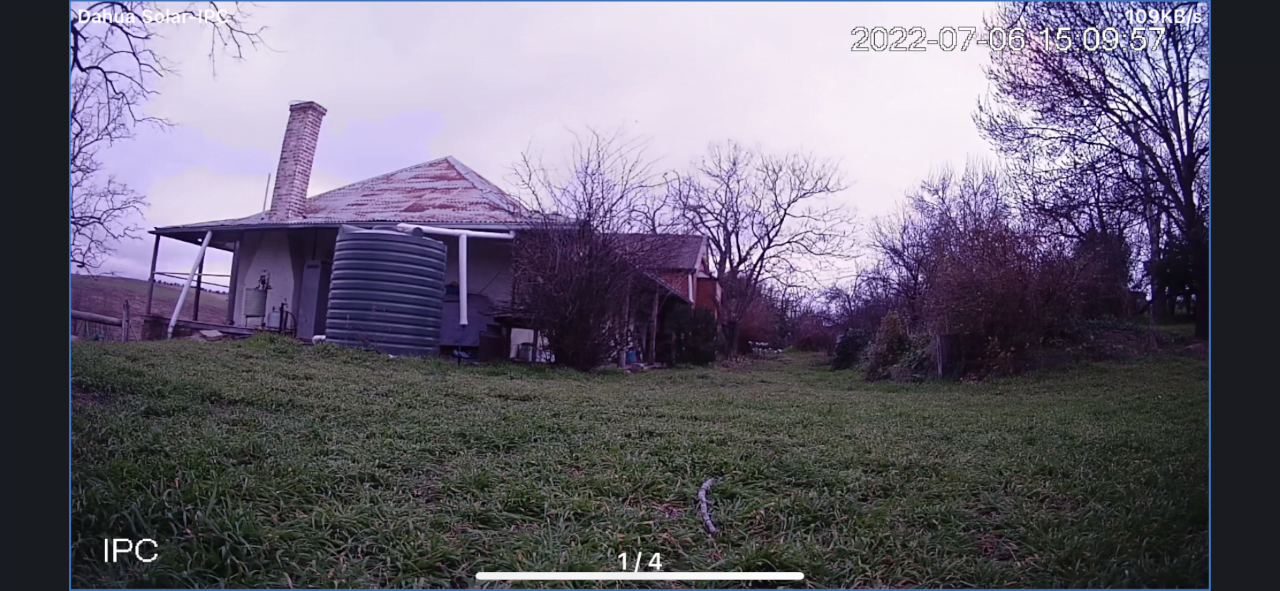
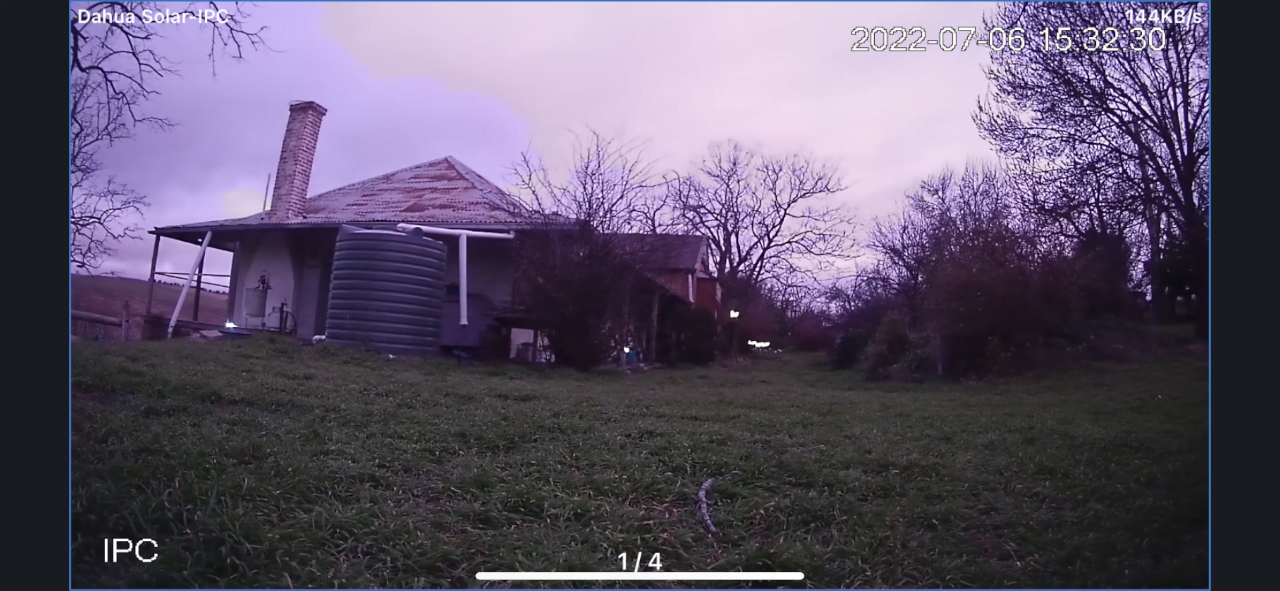
As light drops away, the camera hangs on grimly to colour – something to note is that my camera time is 2 hours behind. After 5pm (3pm on the images), we are getting towards dark and as light levels fall in my scene all the solar lights around the house come on. We are still in colour and the wide view and digital zoom remain useful. At around 3 minutes past 6 in complete darkness the camera finally goes over into night mode.
Effective IR range is around 20-25 metres – the IR spread is very even, save for being slightly more intense directly in front. Unlike some cameras, this Dahua Solar does well with IR all the way out to the edges, which is important in an application where you want to maximize surveillance value across your entire angle of view. As is usually the case, the switch into black and white has enhanced contrast and sharpness.
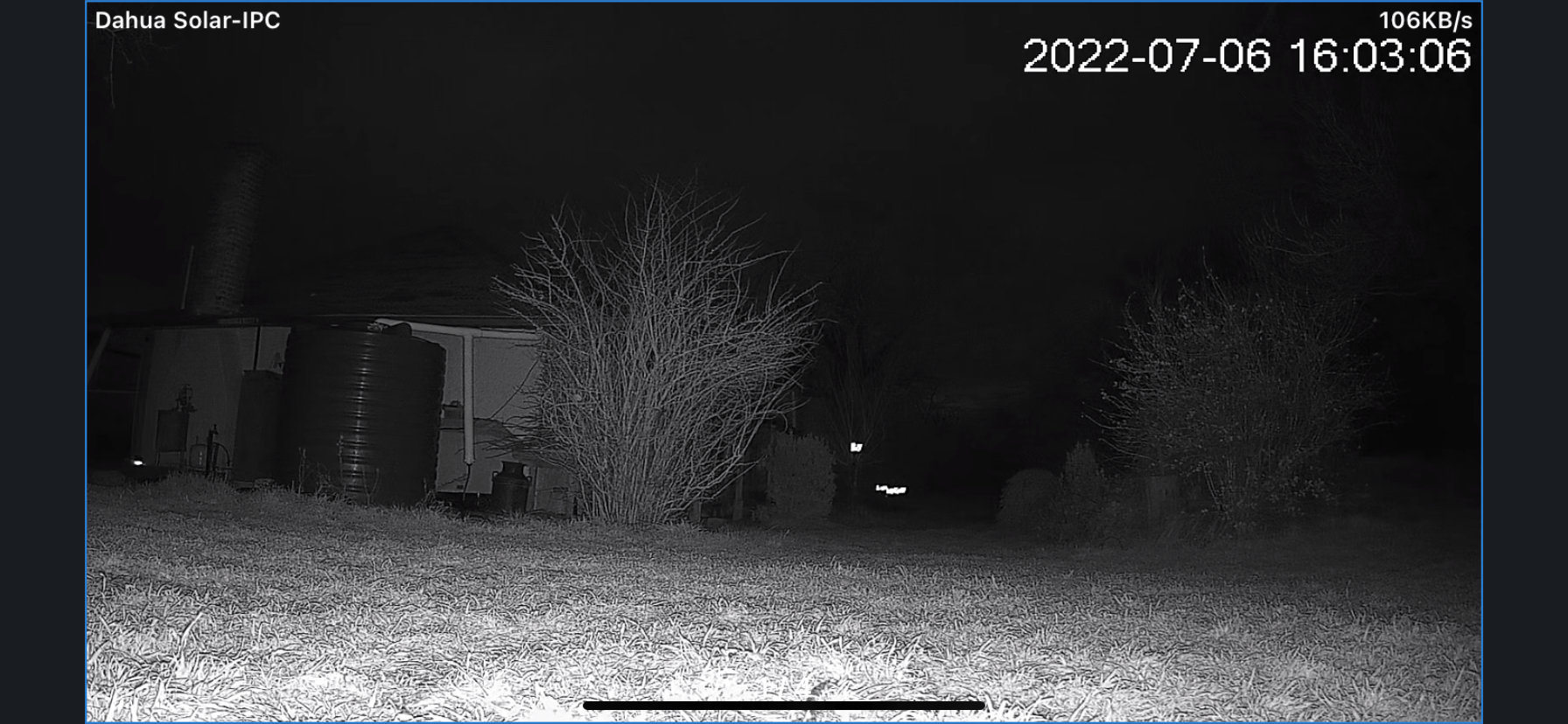
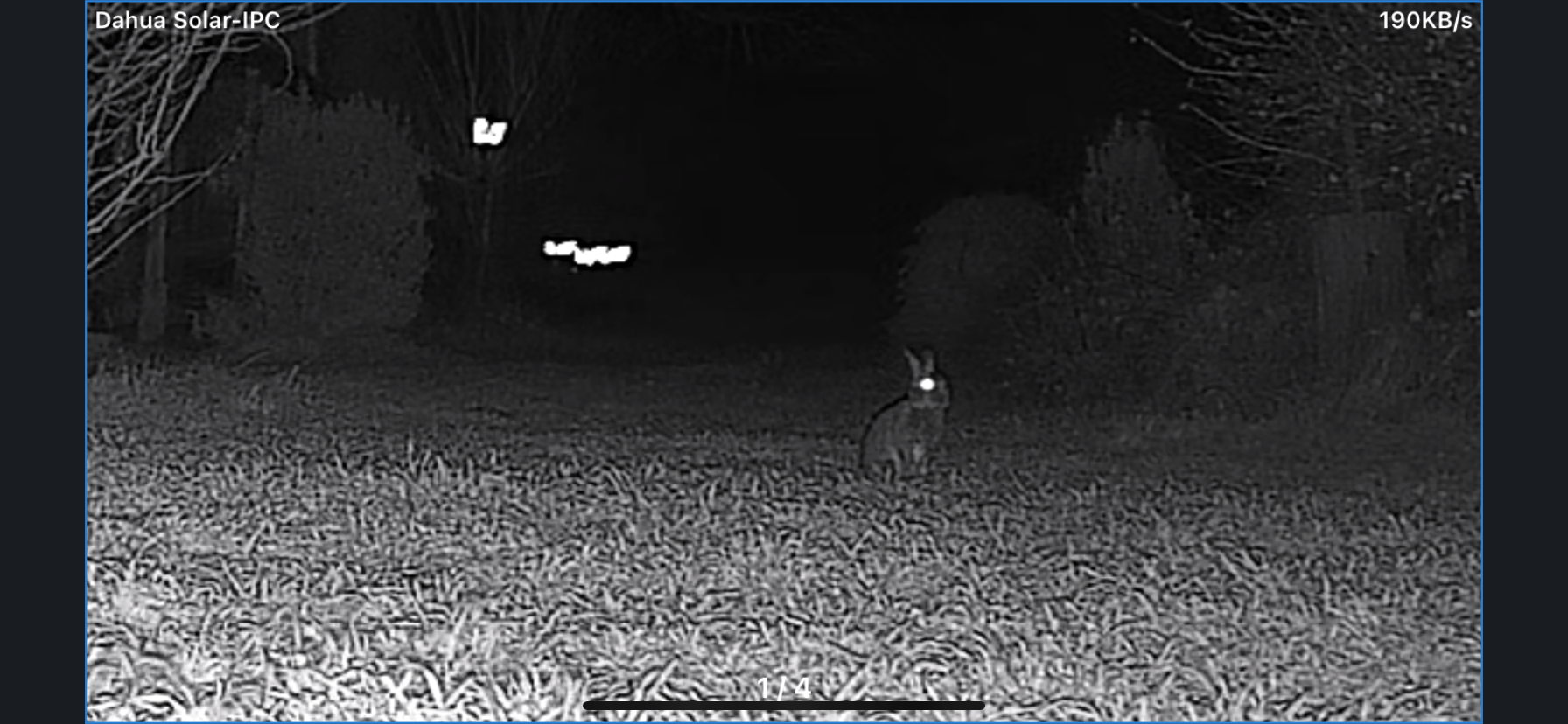
Nobody could move to a depth of 25 metres without being detected and viewable. To make this point, a family of rabbits comes out for a feed – I can make out their ears and eyes at around 15 metres from the lens. Again, digital zoom is useful, and it makes me feel my reach with IR is perhaps a touch greater than I thought – still not the 50 metres claimed in the spec sheets but more than 30 metres for situational awareness.
Conclusions
This solar solution from Dahua, which also comes in a 4MP option, is an excellent surveillance unit that offers considerable flexibility at a competitive price. Perhaps the one negative is the size and weight of the overall structure, but this judgment applies to the form factor of every professional grade integrated solar camera system.
With its moderate fixed lens, the 2MP Dahua camera is best suited to a role requiring situational awareness out to about 40 metres and face recognition within 10 metres during the day. At night there’s situational awareness past 25 metres, with near face recognition to around 10 metres.
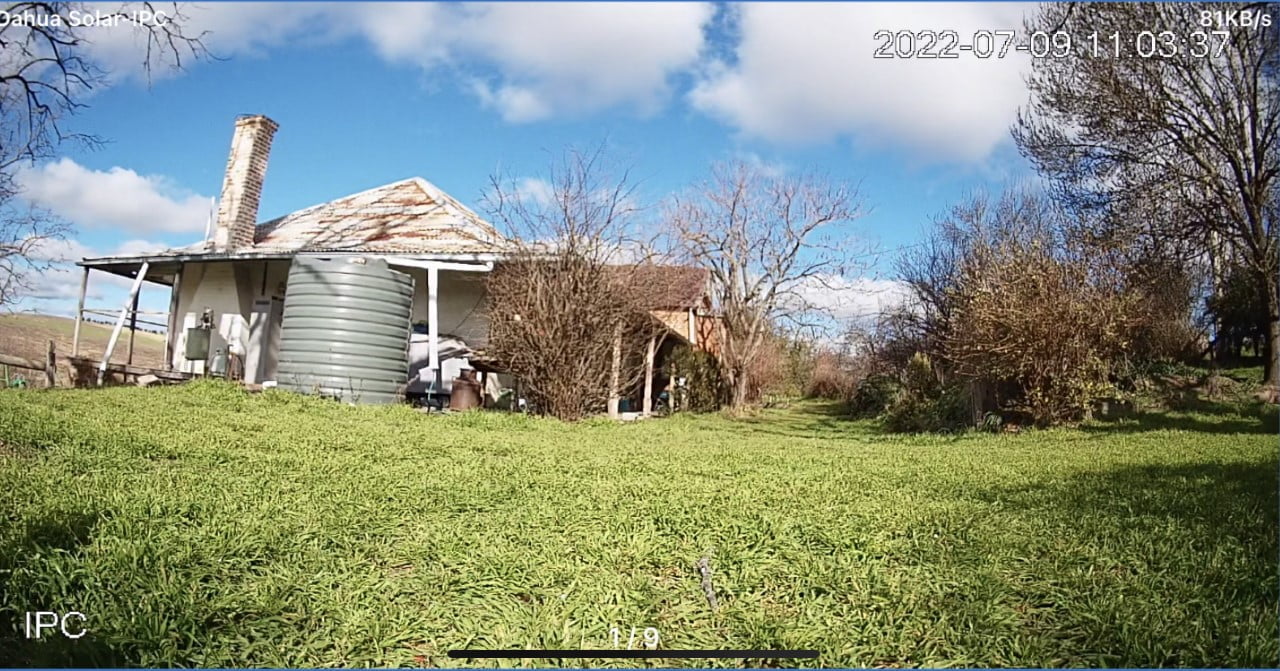
The ability of the camera to deliver strong contrast and comparatively sharp images in monochrome supported by IR is the camera’s forte but performance in colour is good, too, especially when you take into account the modest bitrate.
Regardless, the flexibility of an integrated panel battery camera with 4G that delivers video streams from anywhere to wherever you happen to be is so appealing that it’s impossible not to love this solar solution and I have no desire to give the test unit back to the Dahua team anytime soon.
#SEN #SENnews #security #electronics




